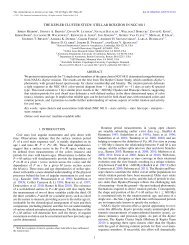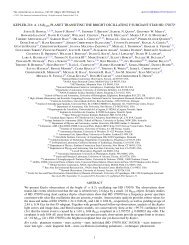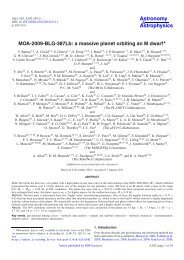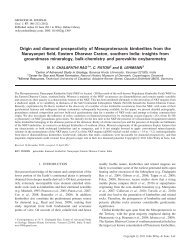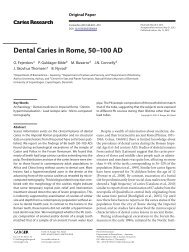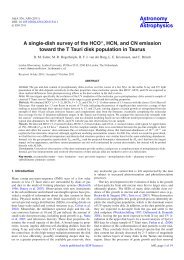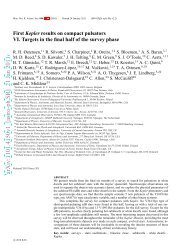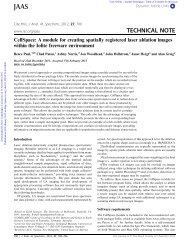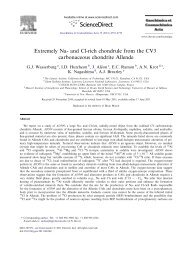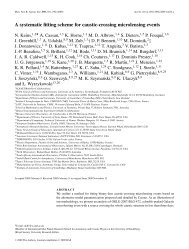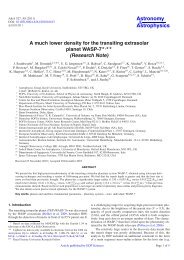Implications of garnet resorption for the Lu–Hf garnet ...
Implications of garnet resorption for the Lu–Hf garnet ...
Implications of garnet resorption for the Lu–Hf garnet ...
You also want an ePaper? Increase the reach of your titles
YUMPU automatically turns print PDFs into web optimized ePapers that Google loves.
J. metamorphic Geol., 2011, 29, 901–916 doi:10.1111/j.1525-1314.2011.00946.x<br />
<strong>Implications</strong> <strong>of</strong> <strong>garnet</strong> <strong>resorption</strong> <strong>for</strong> <strong>the</strong> <strong>Lu–Hf</strong> <strong>garnet</strong><br />
geochronometer: an example from <strong>the</strong> contact aureole <strong>of</strong> <strong>the</strong><br />
Makhavinekh Lake Pluton, Labrador<br />
E. D. KELLY, 1 W. D. CARLSON 1 ANDJ.N.CONNELLY 2<br />
1 Department <strong>of</strong> Geological Sciences, University <strong>of</strong> Texas at Austin, Austin, TX 78712, USA (eric.kelly@mail.utexas.edu)<br />
2 Geological Museum, University <strong>of</strong> Copenhagen, Øster Voldgade 5-7, Copenhagen, Denmark<br />
ABSTRACT In <strong>the</strong> contact aureole <strong>of</strong> <strong>the</strong> Makhavinekh Lake Pluton (MLP), Labrador, <strong>garnet</strong> <strong>resorption</strong> caused<br />
redistribution <strong>of</strong> Lu and loss <strong>of</strong> Hf, creating spuriously young <strong>Lu–Hf</strong> <strong>garnet</strong> ages. Garnet grew during<br />
granulite facies regional metamorphism at 1860–1850 Ma. At 1322 Ma, <strong>garnet</strong> rims were replaced by<br />
coronas <strong>of</strong> cordierite and orthopyroxene during contact metamorphism. Garnet–ilmenite <strong>Lu–Hf</strong><br />
geochronology using bulk-<strong>garnet</strong> separates yields apparent ages that young from 1876 ± 21 Ma at<br />
4025 m from <strong>the</strong> contact to 1396 ± 8 Ma at 450 m from <strong>the</strong> contact. Toward <strong>the</strong> contact, <strong>garnet</strong><br />
crystals are progressively more resorbed. Concentrations <strong>of</strong> Lu measured by LA-ICP-MS along radial<br />
traverses on central sections through relict <strong>garnet</strong> decrease gently away from <strong>the</strong> cores but rise steeply<br />
within 50–200 lm <strong>of</strong> <strong>the</strong> edges <strong>of</strong> <strong>the</strong> relicts. Enrichments <strong>of</strong> Lu in rims <strong>of</strong> relict <strong>garnet</strong> demonstrates<br />
strong partitioning <strong>of</strong> Lu into <strong>garnet</strong> during <strong>resorption</strong> and modest intracrystalline diffusion. Hafnium<br />
distributions could not be measured, but considering <strong>the</strong> strong incompatibility <strong>of</strong> Hf with <strong>garnet</strong>, it is<br />
likely that nearly all Hf in resorbed portions <strong>of</strong> <strong>the</strong> <strong>garnet</strong> was lost from <strong>the</strong> crystals. <strong>Lu–Hf</strong> ages in <strong>the</strong><br />
aureole are thus controlled predominantly by this retention <strong>of</strong> Lu and loss <strong>of</strong> Hf during <strong>garnet</strong><br />
<strong>resorption</strong>. This deduction was tested with a simple numerical model in which <strong>the</strong> partial retention <strong>of</strong> Lu<br />
and loss <strong>of</strong> Hf is tracked as a population <strong>of</strong> <strong>garnet</strong> is resorbed. Assuming a spherical geometry <strong>for</strong> <strong>garnet</strong><br />
porphyroblasts, Rayleigh fractionation is used to approximate initial Lu zoning pr<strong>of</strong>iles ranging from<br />
flat to steeply decreasing toward <strong>garnet</strong> rims. The model simulates: (i) <strong>Lu–Hf</strong> decay <strong>for</strong> a specified period<br />
be<strong>for</strong>e <strong>resorption</strong>; (ii) instantaneous <strong>resorption</strong> with retention <strong>of</strong> Lu and loss <strong>of</strong> Hf from <strong>the</strong> resorbed<br />
portion <strong>of</strong> <strong>the</strong> crystal and (iii) <strong>Lu–Hf</strong> decay during a specified period after <strong>resorption</strong>. Several<br />
parameters influence <strong>the</strong> modelled age, but <strong>garnet</strong> <strong>resorption</strong> and Lu retention are <strong>the</strong> primary factors.<br />
When all o<strong>the</strong>r parameters are held constant, larger amounts <strong>of</strong> <strong>resorption</strong> and higher degrees <strong>of</strong> Lu<br />
retention produce younger apparent ages (false ages). Similarly, flatter initial Lu pr<strong>of</strong>iles yield younger<br />
apparent ages as a consequence <strong>of</strong> <strong>the</strong> larger proportion <strong>of</strong> Lu and Hf that resides in <strong>the</strong> outer portions<br />
<strong>of</strong> <strong>the</strong> porphyroblast. The difference between <strong>the</strong> apparent and actual ages is greater if <strong>the</strong> duration <strong>of</strong><br />
<strong>the</strong> pre-<strong>resorption</strong> decay period is large relative to <strong>the</strong> post-<strong>resorption</strong> decay period. Larger crystals in a<br />
Gaussian crystal-size distribution (CSD) generally dominate <strong>the</strong> <strong>Lu–Hf</strong> budget and produce an older<br />
apparent age relative to <strong>the</strong> age <strong>of</strong> <strong>the</strong> mean crystal size. Compared to a symmetrical Gaussian CSD,<br />
positively skewed CSDs result in reduced <strong>resorption</strong> <strong>of</strong> large crystals and produce an older apparent age.<br />
Application <strong>of</strong> <strong>the</strong> model to <strong>the</strong> MLP aureole, positing growth at 1850 Ma and <strong>resorption</strong> at 1320 Ma,<br />
yields model ages that young from 1850 to 1374 Ma toward <strong>the</strong> contact, in good agreement with <strong>the</strong><br />
apparent ages determined from geochronology.<br />
Key words: Contact aureole; <strong>garnet</strong>; geochronology; lutetium-hafnium; <strong>resorption</strong>.<br />
INTRODUCTION<br />
<strong>Lu–Hf</strong> <strong>garnet</strong> geochronology can be an effective tool<br />
<strong>for</strong> linking P–T conditions with <strong>the</strong> timing <strong>of</strong> geological<br />
events (e.g. Duchene et al., 1997; Blichert-T<strong>of</strong>t<br />
et al., 1999; Philippot et al., 2001; Anczkiewicz et al.,<br />
2007; Kylander-Clark et al., 2007; Lagos et al., 2007).<br />
However, <strong>Lu–Hf</strong> <strong>garnet</strong> geochronology may be hindered<br />
by several obstacles. The factors that can cause<br />
<strong>the</strong> largest differences between <strong>the</strong> calculated age and<br />
<strong>the</strong> actual age <strong>of</strong> <strong>garnet</strong> crystallization are <strong>the</strong> presence<br />
<strong>of</strong> inherited Hf-bearing inclusions in <strong>garnet</strong>, uncertainties<br />
involved with <strong>the</strong> <strong>Lu–Hf</strong> <strong>garnet</strong> closure temperature,<br />
and, as described here, redistribution <strong>of</strong> Lu<br />
and Hf during <strong>garnet</strong> <strong>resorption</strong>.<br />
If inclusions that are rich in Hf (e.g. zircon and<br />
rutile) and that did not achieve isotopic equilibrium<br />
with <strong>garnet</strong> during crystallization are dissolved with<br />
<strong>garnet</strong> during chemical separation, <strong>the</strong>y will alter<br />
<strong>the</strong> 176 Hf ⁄ 177 Hf and 176 Lu ⁄ 177 Hf ratios (DeWolf et al.,<br />
1996; Scherer et al., 2000; Blichert-T<strong>of</strong>t & Frei, 2001),<br />
unless steps are taken during <strong>garnet</strong> dissolution to<br />
Ó 2011 Blackwell Publishing Ltd 901
902 E. D. KELLY ET AL.<br />
avert such contamination (DeWolf et al., 1996;<br />
Connelly, 2006; Lagos et al., 2007).<br />
Analyses <strong>of</strong> <strong>garnet</strong> that experienced temperatures<br />
characteristic <strong>of</strong> granulite and eclogite facies conditions<br />
(>600–700 °C) must account <strong>for</strong> cooling rate<br />
and closure temperature to place accurate boundaries<br />
on <strong>the</strong> timing <strong>of</strong> <strong>garnet</strong> growth. Estimates <strong>for</strong> <strong>the</strong><br />
closure temperature <strong>of</strong> <strong>the</strong> <strong>Lu–Hf</strong> system in <strong>garnet</strong> lie<br />
in <strong>the</strong> range 540–900 °C <strong>for</strong> <strong>the</strong> slow cooling rates<br />
common <strong>for</strong> regional metamorphism, although consensus<br />
is building <strong>for</strong> a closure temperature in <strong>the</strong><br />
range 750–900 °C (Scherer et al., 2000; Anczkiewicz<br />
et al., 2007; Kylander-Clark et al., 2007; Lagos et al.,<br />
2007). In fact, <strong>the</strong> closure temperatures <strong>for</strong> Lu and Hf<br />
in <strong>garnet</strong> appear to be significantly different from one<br />
ano<strong>the</strong>r, which introduces complications <strong>for</strong> interpreting<br />
ages in slowly cooled terranes (Ganguly et al.,<br />
2010).<br />
In this study <strong>of</strong> <strong>garnet</strong> from <strong>the</strong> aureole <strong>of</strong> <strong>the</strong><br />
Makhavinekh Lake Pluton (MLP) in Labrador, an<br />
additional important effect is apparent, namely <strong>the</strong><br />
impact on <strong>Lu–Hf</strong> ages <strong>of</strong> partial <strong>resorption</strong> <strong>of</strong> <strong>garnet</strong> at<br />
high temperature. Such <strong>resorption</strong> is shown here to<br />
produce spuriously young ages, in a pattern that<br />
closely mimics <strong>the</strong> effects expected from partial resetting<br />
by heating in <strong>the</strong> contact aureole. Instead, <strong>the</strong>se<br />
young apparent ages (false ages) are attributed to<br />
partitioning back into <strong>the</strong> relict crystal <strong>of</strong> some <strong>of</strong> <strong>the</strong><br />
Lu liberated by <strong>resorption</strong>, combined with <strong>the</strong> loss <strong>of</strong><br />
Hf from resorbed portions <strong>of</strong> <strong>the</strong> crystal into <strong>the</strong><br />
matrix. The relative importance <strong>of</strong> factors that can<br />
influence <strong>the</strong> apparent age are investigated in a simple<br />
numerical model. Application <strong>of</strong> this model to <strong>the</strong><br />
rocks <strong>of</strong> <strong>the</strong> MLP aureole generates apparent ages that<br />
agree well with apparent ages determined from <strong>Lu–Hf</strong><br />
<strong>garnet</strong>–ilmenite geochronology.<br />
GEOLOGICAL SETTING AND SAMPLE<br />
DESCRIPTIONS<br />
In nor<strong>the</strong>rn Labrador, accretion <strong>of</strong> <strong>the</strong> Nain Province<br />
to <strong>the</strong> Rae (Churchill) Province during <strong>the</strong> Torngat<br />
Orogeny (Fig. 1) buried graphitic, shaley sandstone to<br />
granulite facies conditions (850 °C and 0.6–0.9 GPa),<br />
producing <strong>the</strong> Tasiuyak gneiss (Bertrand et al., 1993;<br />
Theriault & Ermanovics, 1997). Garnet growth at peak<br />
temperatures was accompanied by pervasive partial<br />
melting at 1860–1850 Ma (Lee, 1987; Bertrand et al.,<br />
1993). Movement along <strong>the</strong> Abloviak shear zone produced<br />
a mylonitic fabric starting at c. 1844 Ma, and<br />
unro<strong>of</strong>ing began at 1794–1786 Ma (Bertrand et al.,<br />
1993; Van Kranendonk et al., 1993; Connelly, 2001),<br />
suggesting that granulite facies conditions may have<br />
persisted <strong>for</strong> 50–60 Myr. The MLP intruded <strong>the</strong><br />
Tasiuyak gneiss at 1322 ± 1 Ma (McFarlane et al.,<br />
2005) and produced a 5–6 km wide contact aureole<br />
(Fig. 2) that reached peak temperatures in <strong>the</strong> range <strong>of</strong><br />
700–900 °C (McFarlane et al., 2003) at c. 0.53 GPa<br />
(Carlson, 2006).<br />
(b)<br />
58°N<br />
Quebec<br />
57°<br />
56°<br />
63°<br />
Labrador<br />
MLP<br />
62°W (a)<br />
0 300 km<br />
Nain<br />
Churchill<br />
Prov.<br />
Superior<br />
Prov.<br />
Grenville Prov.<br />
Nain<br />
Province<br />
Labrador<br />
Quebec<br />
Nain Plutonic Suite<br />
Tasiuyak Gneiss<br />
Labrador Sea<br />
50 km<br />
Fig. 1. Location <strong>of</strong> <strong>the</strong> Tasiuyak gneiss and <strong>the</strong> Makhavinekh<br />
Lake Pluton (MLP). (a) The field area is within <strong>the</strong> Nain<br />
Province in nor<strong>the</strong>rn Labrador. (b) The Tasiuyak gneiss underwent<br />
regional metamorphism to granulite facies conditions<br />
during <strong>the</strong> Torngat Orogeny (1860–1850 Ma) and experienced<br />
contact metamorphism in <strong>the</strong> vicinity <strong>of</strong> <strong>the</strong> MLP at<br />
1322 ± 1 Ma (Lee, 1987; Bertrand et al., 1993; McFarlane<br />
et al., 2005). The area <strong>of</strong> Fig. 2 is boxed. Modified from<br />
McFarlane et al. (2003).<br />
MLP<br />
Makhavinekh Lake<br />
M04<br />
900 °C<br />
M22<br />
875 °C<br />
850 °C<br />
M17<br />
Graphitic<br />
Metasedimentary Units<br />
800 °C<br />
Tasiuyak<br />
Gneiss<br />
M08<br />
M12<br />
The Tasiuyak gneiss is composed <strong>of</strong> alternating<br />
melanosomes (<strong>garnet</strong> + sillimanite + biotite + K-feldspar<br />
+ quartz + ilmenite + rutile) and leucosomes<br />
750 °C<br />
1 km<br />
Fig. 2. Simplified map <strong>of</strong> <strong>the</strong> aureole <strong>of</strong> <strong>the</strong> MLP at <strong>the</strong><br />
sou<strong>the</strong>astern boundary. Sample locations and contours <strong>of</strong> peak<br />
contact-metamorphic temperatures are shown. Graphitic<br />
metasedimentary units show <strong>the</strong> trace <strong>of</strong> bedding within <strong>the</strong><br />
aureole. Modified from McFarlane et al. (2005).<br />
N<br />
Ó 2011 Blackwell Publishing Ltd
(quartz + plagioclase + K-feldspar + ilmenite + rutile).<br />
In thin section, most <strong>garnet</strong> is irregular in shape, and<br />
outside <strong>of</strong> <strong>the</strong> <strong>the</strong>rmal aureole, 5–6 km from <strong>the</strong> contact<br />
with <strong>the</strong> MLP, <strong>garnet</strong> is not resorbed (Fig. 3). Garnet<br />
within <strong>the</strong> aureole, however, is surrounded by coronas<br />
<strong>of</strong> orthopyroxene + cordierite ± plagioclase ± spinel<br />
that are progressively thicker toward <strong>the</strong> contact, and<br />
<strong>garnet</strong> is completely resorbed within 450 m <strong>of</strong> <strong>the</strong><br />
contact (Fig. 4). More complete descriptions <strong>of</strong> <strong>the</strong><br />
coronas and <strong>the</strong> reactions that produced <strong>the</strong>m are in<br />
McFarlane et al. (2003) and Carlson (2010).<br />
Samples <strong>of</strong> <strong>garnet</strong>iferous gneiss were collected by<br />
McFarlane et al. (2003) along a radial transect perpendicular<br />
to <strong>the</strong> contact with <strong>the</strong> pluton (Fig. 2). For<br />
geochronology, five <strong>of</strong> <strong>the</strong>se samples were chosen that<br />
span <strong>the</strong> range <strong>of</strong> <strong>resorption</strong> effects, at distances <strong>of</strong><br />
450, 1015, 2025, 3125 and 4025 m from <strong>the</strong> contact.<br />
Lu DISTRIBUTIONS IN RELICT GARNET<br />
The intracrystalline distribution <strong>of</strong> Lu within <strong>garnet</strong><br />
crystals holds vital clues to understanding <strong>the</strong> origin <strong>of</strong><br />
variations in <strong>Lu–Hf</strong> ages within <strong>the</strong> MLP aureole.<br />
Concentrations <strong>of</strong> Lu in <strong>the</strong> interiors <strong>of</strong> relict <strong>garnet</strong><br />
crystals in <strong>the</strong> MLP aureole decrease slightly from <strong>the</strong><br />
cores outward, but increase steeply across <strong>the</strong> outermost<br />
50–200 lm <strong>of</strong> <strong>the</strong> rims. These rim gradients are<br />
attributed to inward intracrystalline diffusion <strong>of</strong> Lu in<br />
response to progressive re-partitioning <strong>of</strong> Lu back into<br />
<strong>garnet</strong> during <strong>resorption</strong> reactions.<br />
Analytical Methods<br />
Concentrations and zoning <strong>of</strong> rare earth elements<br />
(REEs) in relict <strong>garnet</strong> were measured by laser ablation<br />
quadrupole inductively coupled plasma mass<br />
Incipient<br />
corona<br />
Sil<br />
Ilm<br />
Rt<br />
Crd<br />
Grt<br />
Opx<br />
1 mm<br />
Qz<br />
+<br />
Fsp<br />
Sil<br />
Fig. 3. Photomicrograph <strong>of</strong> Tasiuyak gneiss in plane-polarized<br />
light. This sample (T03B) was collected 5750 m from <strong>the</strong> contact<br />
and shows incipient corona development on <strong>garnet</strong> and sillimanite.<br />
Garnet is typically irregular in shape in <strong>the</strong>se rocks.<br />
Abbreviations after Whitney & Evans (2010).<br />
Ó 2011 Blackwell Publishing Ltd<br />
Bt<br />
EFFECTS OF GARNET RESORPTION ON LU-HF AGES 903<br />
spectrometry (LA-ICP-MS), on crystals sectioned<br />
precisely through <strong>the</strong>ir morphological centres as<br />
located by three-dimensional imagery from high-resolution<br />
X-ray computed tomography. Measurements<br />
were made in continuous linear traverses from rim to<br />
core to rim, with <strong>the</strong> specimen translated beneath a<br />
stationary laser beam. Similar, but shorter, linear traverses<br />
<strong>of</strong> NIST SRM 612 were used <strong>for</strong> calibration.<br />
Rare earth element analysis employed a 193 nm<br />
New Wave FX193 excimer laser system with a<br />
low-volume laminar-flow reaction cell (New Wave<br />
Supercell TM ) to minimize washout times, leading to<br />
improved spatial resolution. Ablation products were<br />
analysed with an Agilent 7500ce quadrupole mass<br />
spectrometer. A pre-analysis pass using a 50 lm<br />
diameter spot (10 Hz repetition rate, 10% laser power)<br />
at a translation rate <strong>of</strong> 25 lm s )1 was followed by an<br />
analytical traverse using a 20 lm diameter spot (15 Hz<br />
repetition rate, 40% laser power, irradiance<br />
4.25 GW cm )2 & fluence 6.75 J cm )2 ) at a translation<br />
rate <strong>of</strong> 5 lm s )1 . Dwell times were 10 ms <strong>for</strong> 157 Gd,<br />
163 Dy, 166 Er, 169 Tm and 172 Yb; 20 ms <strong>for</strong> 147 Sm, 159 Tb,<br />
165 Ho and 175 Lu; and 100 ms <strong>for</strong> 140 Ce, 146 Nd and<br />
153 Eu. In <strong>the</strong>se analyses, 29 Si was used as <strong>the</strong> internal<br />
standard <strong>for</strong> calculation <strong>of</strong> ablation-volume corrections;<br />
90 Zr, 137 Ba and 140 Ce were measured to reveal<br />
inadvertent ablation <strong>of</strong> inclusions; and 89 Y was determined<br />
<strong>for</strong> verification <strong>of</strong> <strong>the</strong> deconvolution procedure<br />
described below.<br />
Concentrations <strong>of</strong> Ce and Eu fell below detection<br />
limits <strong>for</strong> LA-ICP-MS and Sm and Nd concentrations<br />
were only slightly above detection limits, but all o<strong>the</strong>r<br />
REEs were present at levels well above detection limits.<br />
Concentrations <strong>of</strong> Lu, <strong>the</strong> focus <strong>of</strong> this study, were<br />
reliably measured at levels <strong>of</strong> 10–200 ppm. An<br />
attempt was also made to determine Hf distributions<br />
by monitoring <strong>the</strong> signal <strong>for</strong> 178 Hf, but concentrations<br />
were below detection limits.<br />
Significant changes in concentration occur over<br />
short distances (50–200 lm) within <strong>garnet</strong> crystals, and<br />
abrupt discontinuities in concentration mark <strong>the</strong><br />
boundary between <strong>garnet</strong> crystals and <strong>the</strong>ir surrounding<br />
matrix. As a result, <strong>the</strong> original concentration<br />
gradients, when measured by LA-ICP-MS, are convolved<br />
to some degree with effects resulting from <strong>the</strong><br />
20 lm spot size, and from particle dispersion during<br />
transport from <strong>the</strong> sample chamber to <strong>the</strong> plasma.<br />
These effects spread <strong>the</strong> signal in time and distance<br />
along <strong>the</strong> traverse, although <strong>the</strong> impact is appreciable<br />
only at <strong>the</strong> two positions where sharp curvature is<br />
present in <strong>the</strong> concentration pr<strong>of</strong>ile: approaching <strong>the</strong><br />
outermost <strong>garnet</strong> rim and at <strong>the</strong> discontinuity represented<br />
by <strong>the</strong> edge <strong>of</strong> <strong>the</strong> crystal. A deconvolution<br />
procedure based on algorithms devised by Ganguly<br />
et al. (1988) <strong>for</strong> EPMA removes this convolution<br />
artefact (Fig. 5). The procedure assumes a Gaussian<br />
distribution <strong>of</strong> <strong>the</strong> signal intensity as a function <strong>of</strong><br />
distance from <strong>the</strong> spotÕs centre, thus specifying <strong>the</strong><br />
relationship <strong>of</strong> <strong>the</strong> original concentration pr<strong>of</strong>ile to <strong>the</strong>
904 E. D. KELLY ET AL.<br />
M04:450 m<br />
98%<br />
M21:1500 m<br />
63%<br />
convolved measurements. Estimates <strong>of</strong> <strong>the</strong> actual<br />
concentration pr<strong>of</strong>ile are convolved with <strong>the</strong> Gaussian<br />
point-spread function, <strong>the</strong>n compared to <strong>the</strong> measured<br />
LA-ICP-MS data and adjusted until a good visual fit is<br />
achieved that matches <strong>the</strong> convolved pr<strong>of</strong>ile to <strong>the</strong><br />
measurements. The width <strong>of</strong> <strong>the</strong> Gaussian function,<br />
which is comparable in size to <strong>the</strong> laser spot diameter,<br />
is treated as an adjustable parameter, but it is strongly<br />
constrained by how abruptly <strong>the</strong> signal falls <strong>of</strong>f when<br />
<strong>the</strong> edge <strong>of</strong> <strong>the</strong> crystal is traversed. The accuracy <strong>of</strong> this<br />
deconvolution method can be tested, because concentrations<br />
<strong>of</strong> minor elements, such as Y, can be measured<br />
by both EPMA and LA-ICP-MS. The results <strong>of</strong><br />
deconvolution <strong>of</strong> <strong>the</strong> LA-ICP-MS data <strong>for</strong> Y, <strong>for</strong><br />
instance, can be compared with those made at higher<br />
spatial resolution by EPMA, to verify <strong>the</strong> correctness<br />
<strong>of</strong> <strong>the</strong> procedure (Fig. 5b).<br />
Because concentrations <strong>of</strong> light rare earth elements<br />
were near or below <strong>for</strong>mal detection limits <strong>for</strong><br />
M11:3900 m<br />
Fig. 4. Backscattered electron images showing progressive <strong>garnet</strong> <strong>resorption</strong>. The distance from <strong>the</strong> contact with <strong>the</strong> MLP is given<br />
in metres, and <strong>the</strong> amount <strong>of</strong> <strong>garnet</strong> <strong>resorption</strong> is given in volume per cent. Relatively spherical <strong>garnet</strong> was carefully located by X-ray<br />
computed tomography and centrally sectioned <strong>for</strong> measurements <strong>of</strong> Lu concentrations and radius. Radial measurements were<br />
used to estimate <strong>resorption</strong> amounts. Scale bars are 1 mm in length.<br />
(a)<br />
80<br />
70 Lu<br />
ppm<br />
60<br />
M04A1c<br />
(b)<br />
1200<br />
Y<br />
1000<br />
ppm<br />
50<br />
LA-ICP-MS 800<br />
40<br />
30<br />
20<br />
10<br />
0<br />
0 100 200 300 400 500 600<br />
Distance (µm)<br />
EPMA<br />
Convolved<br />
Actual<br />
9%<br />
LA-ICP-MS, supplementary data in <strong>the</strong> <strong>for</strong>m <strong>of</strong><br />
near-rim pr<strong>of</strong>iles <strong>for</strong> Nd, Sm and Eu were obtained<br />
via secondary ion mass spectrometry (SIMS) (Cameca<br />
IMS 6f, Arizona State University). A primary<br />
ion beam <strong>of</strong> 16 O ) (current 4–5 nA, nominal beam<br />
diameter 20 lm) was accelerated from <strong>the</strong> duoplasmatron<br />
source at )12.5 kV while <strong>the</strong> sample was<br />
held at +9 kV. Positive secondary ions were detected<br />
using an electron multiplier in pulse-counting<br />
mode. The mass spectrometer was operated at low<br />
mass resolution (M ⁄DM 300) and energy filtering<br />
was used to remove interfering molecular species<br />
(Shimizu et al., 1978; Zinner & Crozaz, 1986).<br />
Sample voltage was <strong>of</strong>fset by 75 V from <strong>the</strong> peak<br />
secondary-ion signal and thus only those ions with<br />
75 ± 20 eV excess kinetic energy entered <strong>the</strong> mass<br />
spectrometer. Each analysis consisted <strong>of</strong> a pre-sputter<br />
time <strong>of</strong> 420 s followed by 40 measurement cycles<br />
<strong>for</strong> 30 Si, 89 Y, 144 Nd, 147 Sm and 151 Eu; analyses <strong>of</strong> Y<br />
600<br />
400<br />
200<br />
M04A1c<br />
0<br />
0 100 200 300 400 500 600<br />
Distance (µm)<br />
Fig. 5. Examples <strong>of</strong> deconvolution procedure. Estimate <strong>of</strong> actual pr<strong>of</strong>ile (heavy line) is convolved with Gaussian filter to produce<br />
convolved curve (light line); estimate is adjusted until convolved curve con<strong>for</strong>ms to range <strong>of</strong> LA-ICP-MS measurements (dots).<br />
Accuracy is verified by comparing results from deconvolution procedure (heavy line) with measurements made by EPMA (open circles<br />
in b) <strong>for</strong> minor elements (here, Y).<br />
Ó 2011 Blackwell Publishing Ltd
400<br />
Yb<br />
ppm<br />
300<br />
200<br />
100<br />
0<br />
40<br />
20<br />
0<br />
25<br />
20<br />
15<br />
10<br />
5<br />
0<br />
2.5<br />
2.0<br />
1.5<br />
1.0<br />
0.5<br />
Ho<br />
ppm<br />
Gd<br />
ppm<br />
Nd<br />
ppm<br />
Enrichment<br />
= 5.6 X<br />
Enrichment<br />
= 3.0 X<br />
Enrichment<br />
= 2.4 X<br />
0.0<br />
0 200 400 600 800<br />
Distance from centre (µm)<br />
Ó 2011 Blackwell Publishing Ltd<br />
Depletion<br />
= 0.3 X<br />
EFFECTS OF GARNET RESORPTION ON LU-HF AGES 905<br />
were made <strong>for</strong> comparison with LA-ICP-MS data,<br />
and all count rates were normalized to that <strong>for</strong> 30 Si.<br />
Errors indicated by <strong>the</strong> integrated signals <strong>for</strong> <strong>the</strong><br />
REEs (and Y) were
906 E. D. KELLY ET AL.<br />
ppm Lu<br />
ppm Lu<br />
70<br />
60<br />
50<br />
40<br />
30<br />
70<br />
60<br />
50<br />
40<br />
30<br />
70<br />
70<br />
450 m 60 800 m 60 1100 m<br />
926 °C<br />
M04A1e<br />
50<br />
911 °C<br />
M05C1e<br />
50<br />
894 °C<br />
M20D1b<br />
20<br />
10<br />
d = 174 µm<br />
0<br />
0 200 400 600 800<br />
Distance from centre (µm)<br />
1500 m<br />
882 °C<br />
M21C1c<br />
20<br />
10<br />
d = 102 µm<br />
0<br />
0 200 400 600 800<br />
Distance from centre (µm)<br />
100 between <strong>garnet</strong> and whole-rock metapelitic<br />
assemblages that include biotite + muscovite + plagioclase<br />
+ quartz ± kyanite ± rutile ± ilmenite. The<br />
strongly zoned Lu pr<strong>of</strong>iles typical <strong>of</strong> most growth<br />
zoning are unlike <strong>the</strong> relatively gentle gradients now<br />
present in <strong>the</strong> interiors <strong>of</strong> <strong>the</strong> relict <strong>garnet</strong> in <strong>the</strong> MLP<br />
aureole. As described above, <strong>garnet</strong> in <strong>the</strong> Tasiuyak<br />
gneiss <strong>for</strong>med during a deep-crustal (0.6–0.9 GPa)<br />
partial-melting event at temperatures near 850 °C (Lee,<br />
1987), and may not have cooled substantially until<br />
uplift began some 65 Myr later (Van Kranendonk<br />
et al., 1993). This protracted residence at very high<br />
temperature would have made possible <strong>the</strong> flattening<br />
<strong>of</strong> originally steep REE concentration pr<strong>of</strong>iles by<br />
intracrystalline diffusion. This interpretation is<br />
supported by <strong>the</strong> observation that interior gradients<br />
tend to be shallower in smaller crystals, <strong>the</strong> expected<br />
result <strong>of</strong> partial homogenization by diffusion, as<br />
illustrated <strong>for</strong> major elements at lower temperatures by<br />
Carlson & Schwarze (1997). (<strong>the</strong> Lu pr<strong>of</strong>iles in Fig. 7<br />
show an apparently systematic decrease in core<br />
concentration <strong>for</strong> crystals progressively more distant<br />
from <strong>the</strong> contact, but this is merely coincidental; core<br />
concentrations depend on bulk-rock abundances and<br />
on <strong>the</strong> sizes <strong>of</strong> <strong>the</strong> crystals, as homogenization <strong>of</strong> larger<br />
crystals leads to greater dilution <strong>of</strong> initial core<br />
concentrations).<br />
ppm Lu<br />
40<br />
30<br />
20<br />
d = 138 µm<br />
10<br />
0<br />
0 200 400 600 800<br />
Distance from centre (µm)<br />
ppm Lu<br />
70<br />
60<br />
50<br />
40<br />
30<br />
20<br />
2025 m<br />
861 °C<br />
M22B1h<br />
ppm Lu<br />
40<br />
30<br />
20<br />
10<br />
d = 116 µm<br />
0<br />
0 200 400 600 800<br />
Distance from centre (µm)<br />
10<br />
d = 87 µm<br />
0<br />
0 200 400 600 800 1000 1200 1400 1600<br />
Distance from centre (µm)<br />
Fig. 7. Core-to-rim pr<strong>of</strong>iles <strong>of</strong> Lu zoning in five relict <strong>garnet</strong> crystals from <strong>the</strong> aureole <strong>of</strong> <strong>the</strong> MLP, with distances from contact and<br />
corresponding peak temperatures during <strong>resorption</strong> episode. Scaling is identical <strong>for</strong> all pr<strong>of</strong>iles. The depth d to which steep concentration<br />
gradients extend into <strong>the</strong> crystal is defined here as <strong>the</strong> distance from <strong>the</strong> rim <strong>of</strong> <strong>the</strong> relict crystal to <strong>the</strong> position <strong>of</strong> <strong>the</strong> minimum<br />
in <strong>the</strong> pr<strong>of</strong>ile; d increases with proximity to <strong>the</strong> contact and with inferred peak temperatures, consistent with <strong>the</strong> origin <strong>of</strong> <strong>the</strong>se<br />
gradients by inward diffusion <strong>of</strong> Lu during <strong>resorption</strong>.<br />
The steep pr<strong>of</strong>iles <strong>for</strong> Lu near <strong>the</strong> edges <strong>of</strong> relict<br />
crystals (Fig. 7) are interpreted to be <strong>the</strong> result <strong>of</strong><br />
strong preferential re-partitioning <strong>of</strong> Lu into <strong>the</strong> outermost<br />
rims <strong>of</strong> <strong>the</strong> crystals during <strong>resorption</strong>, accompanied<br />
by appreciable but limited inward diffusion.<br />
Uptake <strong>of</strong> Lu into <strong>garnet</strong> during <strong>resorption</strong> is expected<br />
on <strong>the</strong> basis <strong>of</strong> large partition coefficients relative to<br />
cordierite + orthopyroxene + accessory monazite,<br />
<strong>the</strong> coronal minerals that are <strong>the</strong> products <strong>of</strong> <strong>resorption</strong>.<br />
For <strong>garnet</strong> v. cordierite, extrapolation <strong>of</strong> <strong>the</strong> data<br />
<strong>of</strong> Otamendi et al. (2002) on measured partition coefficients<br />
as a function <strong>of</strong> ionic radius implies a value <strong>of</strong><br />
300–400; those data (Table 1) are <strong>for</strong> Dy, Y, Er and<br />
Yb in <strong>garnet</strong> v. cordierite + plagioclase + quartz.<br />
For <strong>garnet</strong> v. orthopyroxene, <strong>the</strong> partitioning measured<br />
by Carlson et al. (2007) at comparable temperatures<br />
but higher pressures implies a value close to 100<br />
(cf. Burgess & Harte, 2004). In this respect, Lu is<br />
behaving similarly to Y and Mn – two o<strong>the</strong>r elements<br />
with a strong affinity <strong>for</strong> <strong>garnet</strong> – that commonly<br />
develop annuli <strong>of</strong> high concentrations in <strong>the</strong> rims <strong>of</strong><br />
relict crystals: <strong>the</strong>se compatible elements, when freed<br />
from portions <strong>of</strong> <strong>the</strong> crystal that are consumed, backdiffuse<br />
into <strong>the</strong> relict <strong>garnet</strong> (Lanzirotti, 1995; Pyle &<br />
Spear, 1999; Carlson, 2002; Kohn & Malloy, 2004;<br />
Kohn, 2009). A similar interpretation <strong>for</strong> <strong>the</strong> high-Lu<br />
rims in <strong>garnet</strong> <strong>of</strong> <strong>the</strong> MLP aureole is supported by:<br />
Ó 2011 Blackwell Publishing Ltd
Table 1. Effective ionic radius and partition coefficients <strong>for</strong><br />
elements in <strong>garnet</strong>.<br />
Element<br />
(i) <strong>the</strong> pattern <strong>of</strong> more pronounced increases at rims<br />
<strong>for</strong> heavier REEs, coupled with <strong>the</strong> reversal <strong>of</strong> pr<strong>of</strong>ile<br />
slopes to yield decreases at rims <strong>for</strong> REEs lighter than<br />
Gd, demonstrating <strong>the</strong> role <strong>of</strong> partitioning <strong>of</strong> REEs<br />
between <strong>the</strong> reacting <strong>garnet</strong> and <strong>the</strong> product cordierite<br />
+ orthopyroxene + monazite (Fig. 6); (ii) <strong>the</strong><br />
greater penetration distances observed <strong>for</strong> crystals in<br />
hotter portions <strong>of</strong> <strong>the</strong> aureole, demonstrating <strong>the</strong> role<br />
<strong>of</strong> diffusion in redistributing Lu inward toward <strong>the</strong><br />
interior portions <strong>of</strong> <strong>the</strong> <strong>garnet</strong> crystals (Fig. 7) and (iii)<br />
<strong>the</strong> ability <strong>of</strong> numerical models <strong>of</strong> intracrystalline diffusion<br />
to replicate <strong>the</strong> shapes <strong>of</strong> <strong>the</strong> pr<strong>of</strong>iles (Fig. 8).<br />
Material-balance Calculations<br />
Important to <strong>the</strong> interpretation <strong>of</strong> <strong>Lu–Hf</strong> ages in <strong>the</strong><br />
MLP aureole are estimates <strong>of</strong> <strong>the</strong> amounts <strong>of</strong> Lu<br />
retained within <strong>garnet</strong> crystals v. <strong>the</strong> amounts lost to<br />
<strong>the</strong> surrounding matrix during partial <strong>resorption</strong>. The<br />
fraction <strong>of</strong> Lu that is retained will depend on several<br />
8.0<br />
Lu (10 –7 mol cm –3 )<br />
a Effective ionic radius in<br />
eightfold coordination (A˚ )<br />
Charge<br />
Hf 0.830 4+ –<br />
Mg 0.890 2+ –<br />
Lu 0.977 3+ –<br />
Yb 0.985 3+ 265<br />
Er 1.004 3+ 146<br />
Y 1.019 3+ 80<br />
Dy 1.027 3+ 54<br />
Ca 1.120 2+ –<br />
Matrix = quartz + plagioclase + cordierite.<br />
a<br />
Shannon (1976).<br />
b<br />
Otamendi et al. (2002).<br />
LA-ICP-MS measurement<br />
Diffusion model<br />
M05C1e<br />
b b Grt ⁄ matrix<br />
0.0<br />
0.00 0.01 0.02 0.03 0.04 0.05 0.06 0.07<br />
Distance from centre (cm)<br />
Fig. 8. Comparison <strong>of</strong> measured Lu concentrations (open<br />
circles) with calculated diffusion pr<strong>of</strong>ile (solid line), generated<br />
using <strong>the</strong> modelling approach and <strong>the</strong>rmal histories described in<br />
Carlson (2006). Close correspondence supports interpretation <strong>of</strong><br />
Lu retention due to re-partitioning and inward intracrystalline<br />
diffusion <strong>of</strong> Lu into <strong>garnet</strong> during <strong>resorption</strong> reactions.<br />
Ó 2011 Blackwell Publishing Ltd<br />
EFFECTS OF GARNET RESORPTION ON LU-HF AGES 907<br />
factors. Two <strong>of</strong> <strong>the</strong> most influential factors are <strong>the</strong><br />
equilibrium partition coefficients <strong>for</strong> Lu between <strong>garnet</strong><br />
and cordierite and between <strong>garnet</strong> and orthopyroxene,<br />
which are large at <strong>the</strong> temperatures <strong>of</strong><br />
<strong>resorption</strong>, as described above. Such large values<br />
would imply a high degree <strong>of</strong> Lu retention in <strong>garnet</strong> if<br />
equilibrium were to be achieved, but <strong>the</strong> material<br />
re-partitioning into <strong>the</strong> <strong>garnet</strong> at its outer surface can<br />
only be retained to <strong>the</strong> extent that it is able to diffuse<br />
into <strong>the</strong> interior <strong>of</strong> <strong>the</strong> crystal, which limits <strong>the</strong> degree<br />
to which <strong>the</strong> actual bulk distribution approaches<br />
equilibrium partitioning. Consequently, <strong>the</strong> temperature<br />
at which <strong>resorption</strong> occurs becomes a third<br />
important factor, because it controls <strong>the</strong> distance<br />
within <strong>the</strong> relict crystal over which Lu can diffuse.<br />
An attempt was made to determine <strong>the</strong> proportions<br />
<strong>of</strong> Lu retained during <strong>resorption</strong> reactions in <strong>the</strong> MLP<br />
aureole from a simple material balance that compares<br />
<strong>the</strong> total amount <strong>of</strong> Lu found in <strong>the</strong> relict crystal with<br />
an estimate <strong>of</strong> <strong>the</strong> amount originally present in <strong>the</strong><br />
crystal be<strong>for</strong>e <strong>resorption</strong>. The Lu initially present can<br />
be estimated by assuming spherical symmetry and<br />
extrapolating <strong>the</strong> gently sloping Lu pr<strong>of</strong>iles present in<br />
<strong>the</strong> interiors <strong>of</strong> relict crystals out to <strong>the</strong> radii <strong>of</strong> <strong>the</strong><br />
original crystals, which lie at a position in each corona<br />
nearly coincident with <strong>the</strong> boundary between <strong>the</strong> inner<br />
cordierite + orthopyroxene layer and <strong>the</strong> outer<br />
orthopyroxene ± plagioclase layer (Carlson, 2010).<br />
The results <strong>of</strong> <strong>the</strong>se calculations, however, turned out<br />
to be subject to very large uncertainties because <strong>the</strong><br />
estimates <strong>of</strong> prior concentrations in now-vanished<br />
<strong>garnet</strong>, based on outward extrapolations <strong>of</strong> interior<br />
compositions, cannot be adequately constrained.<br />
<strong>Lu–Hf</strong> GARNET GEOCHRONOLOGY<br />
Mineral separates used in this work were derived from<br />
<strong>the</strong> study reported in McFarlane et al. (2006), in which<br />
minerals were separated by standard techniques<br />
(Wilfley table, sieving, Franz magnetic separator &<br />
heavy liquids). Garnet, ilmenite and rutile fractions<br />
were handpicked to a purity <strong>of</strong> >99% using a binocular<br />
microscope. Garnet separates sealed in evacuated<br />
silica glass ampoules were annealed in a furnace at<br />
1000 °C <strong>for</strong> 48 h prior to dissolution in HCl plus a<br />
minor amount <strong>of</strong> HF, to minimize or eliminate <strong>the</strong><br />
incorporation <strong>of</strong> Hf from zircon inclusions within <strong>the</strong><br />
<strong>garnet</strong> porphyroblasts, according to methods outlined<br />
by Connelly (2006). Purification <strong>of</strong> Lu and Hf from<br />
<strong>garnet</strong>, ilmenite and rutile utilized a first-stage cation<br />
column and a second-stage TODGA (Eichrom Industries)<br />
following <strong>the</strong> methods outlined in Connelly et al.<br />
(2006). Lutetium and Hf were analysed using two<br />
different multi-collector inductively coupled plasma<br />
mass spectrometers: <strong>garnet</strong> was analysed on an Axiom<br />
at Copenhagen University, whereas ilmenite and rutile<br />
were analysed on a Micromass Isoprobe at The<br />
University <strong>of</strong> Texas at Austin. Data were reduced<br />
using in-house programs according to <strong>the</strong> protocol
908 E. D. KELLY ET AL.<br />
outlined in Connelly et al. (2006). The results <strong>of</strong> running<br />
standards BHVO-1 and BCR-2 at Copenhagen<br />
University and The University <strong>of</strong> Texas at Austin<br />
during <strong>the</strong> course <strong>of</strong> this study are summarized in<br />
Connelly et al. (2006). We use <strong>the</strong> reproducibility <strong>of</strong><br />
<strong>the</strong>se standards as an estimate <strong>of</strong> <strong>the</strong> errors <strong>for</strong> <strong>the</strong><br />
176 Lu ⁄ 177 Hf analyses in this study because <strong>of</strong> <strong>the</strong><br />
dependence <strong>of</strong> this variable on unquantified weighing<br />
errors <strong>of</strong> our unmixed spike. These errors, combined<br />
with internal errors from <strong>the</strong> Hf isotopic analyses,<br />
provide uncertainties <strong>for</strong> <strong>the</strong> ages (Table 2).<br />
Both ilmenite and rutile crystallized with <strong>garnet</strong><br />
during <strong>the</strong> regional metamorphic event, but <strong>the</strong> contact<br />
event promoted additional ilmenite growth. All samples<br />
contain abundant ilmenite, but only three samples<br />
contain rutile in sufficient quantities <strong>for</strong> isotopic<br />
analysis. There<strong>for</strong>e, <strong>the</strong> three rutile separates were<br />
processed along with <strong>the</strong> ilmenite separates to monitor<br />
<strong>the</strong> influence <strong>of</strong> <strong>the</strong> second ilmenite growth event on<br />
<strong>the</strong> overall ilmenite isotopic ratios. The differences<br />
between <strong>the</strong> ilmenite and rutile are within <strong>the</strong> stated<br />
errors and thus insignificant in <strong>the</strong> age determinations,<br />
especially in <strong>the</strong> context <strong>of</strong> this study. As ilmenite was<br />
present in all samples, <strong>the</strong> ages discussed below were<br />
determined from <strong>garnet</strong>–ilmenite pairs. Using <strong>the</strong><br />
decay constant <strong>of</strong> So¨ derlund et al. (2004), <strong>the</strong> ages<br />
range from 1876 ± 21 to 1396 ± 8 Ma toward <strong>the</strong><br />
pluton (Table 2). The trend <strong>of</strong> decreasing ages toward<br />
<strong>the</strong> pluton is illustrated by <strong>the</strong> trend <strong>of</strong> decreasing<br />
slopes <strong>of</strong> <strong>the</strong> two-point ÔisochronsÕ (Fig. 9).<br />
REDISTRIBUTION OF Lu AND Hf DURING<br />
GARNET RESORPTION<br />
It is tempting to ascribe <strong>the</strong> age progression within <strong>the</strong><br />
MLP aureole documented above to partial resetting<br />
caused by heating during contact metamorphism.<br />
However, resetting can be complicated, especially in<br />
Table 2. Apparent ages from <strong>Lu–Hf</strong> geochronology.<br />
Sample ⁄ mineral Lu (ppm) Hf (ppm) Weight (g)<br />
<strong>the</strong> <strong>Lu–Hf</strong> system where <strong>the</strong> diffusivity <strong>of</strong> Lu is one to<br />
two orders <strong>of</strong> magnitude higher than that <strong>of</strong> Hf at <strong>the</strong><br />
temperatures <strong>of</strong> <strong>the</strong> MLP aureole (Kohn, 2009;<br />
Ganguly et al., 2010). As described above, <strong>the</strong> <strong>garnet</strong><br />
from <strong>the</strong> MLP aureole shows evidence <strong>for</strong> significant<br />
Lu intracrystalline diffusion. In contrast, much slower<br />
Hf intracrystalline diffusion, owing to its high charge,<br />
combined with <strong>the</strong> rapid initial cooling rates in <strong>the</strong><br />
aureole (>10 °C Myr )1 ; Carlson, 2006) would not<br />
permit significant Hf diffusion at <strong>the</strong>se temperatures<br />
(Ganguly et al., 2010). In addition to differences in<br />
closure temperature, resetting is complicated by <strong>the</strong><br />
different partitioning behaviours <strong>of</strong> Lu and Hf<br />
between <strong>garnet</strong> and matrix phases.<br />
As already noted, Lu partitions strongly into relict<br />
<strong>garnet</strong> during <strong>resorption</strong>, ra<strong>the</strong>r than into product<br />
cordierite and orthopyroxene. At <strong>the</strong> temperatures that<br />
affected <strong>the</strong> MLP aureole, <strong>the</strong> diffusivity <strong>of</strong> Lu in<br />
<strong>garnet</strong> is sufficient to convey appreciable amounts <strong>of</strong><br />
Lu from <strong>the</strong> surface <strong>of</strong> <strong>the</strong> <strong>garnet</strong> crystals into <strong>the</strong>ir<br />
176 Lu ⁄ 177 Hf Error (%)<br />
176 Hf ⁄ 177 Hf Error (%) Age (Ma)<br />
M04: 450 m<br />
Garnet 14.480 0.680 0.0538 3.00469 0.33 0.360426 0.0120 1396 ± 8<br />
Ilmenite 0.899 8.938 0.0151 0.01429 0.50 0.281470 0.0040<br />
M17: 1015 m<br />
Garnet 2.674 0.872 0.0600 0.43526 0.33 0.295767 0.0019 1740 ± 29<br />
Ilmenite 0.095 21.904 0.0110 0.00061 0.50 0.281419 0.0080<br />
M22: 2025 m<br />
Garnet 3.129 0.901 0.0930 0.49218 0.33 0.297668 0.0022 1782 ± 9<br />
Rutile 0.011 98.038 0.0147 0.000016 0.50 0.281022 0.0021 1764 ± 25<br />
Ilmenite 0.132 26.289 0.0099 0.00071 0.50 0.281213 0.0018<br />
M08: 3125 m<br />
Garnet 2.766 0.786 0.0650 0.49985 0.33 0.298113 0.0024 1799 ± 10<br />
Rutile 0.020 92.188 0.0161 0.000031 0.50 0.281041 0.0060 1773 ± 25<br />
Ilmenite 0.110 26.106 0.0085 0.00060 0.50 0.281311 0.0016<br />
M12: 4025 m<br />
Garnet 3.810 0.823 0.0560 0.65765 0.33 0.304707 0.0030 1872 ± 9<br />
Rutile 0.035 89.554 0.0052 0.000055 0.50 0.281315 0.0025 1876 ± 21<br />
Ilmenite 0.094 50.088 0.0068 0.00027 0.50 0.281275 0.0016<br />
176 177 176 177<br />
Hf ⁄ Hf errors are internal and Lu ⁄ Hf errors are estimated from standard reproducibility.<br />
Errors are 2 SD.<br />
Ages were calculated using <strong>the</strong> decay constant <strong>of</strong> So¨ derlund et al. (2004).<br />
0.36<br />
0.34<br />
0.32<br />
0.30<br />
0.28<br />
176 Hf/ 177 Hf<br />
1015 m<br />
2025 m<br />
3125 m<br />
4025 m<br />
450 m<br />
176 Lu/ 177 Hf<br />
0.0 0.5 1.0 1.5 2.0 2.5 3.0 3.5<br />
Fig. 9. Garnet–ilmenite two-point <strong>Lu–Hf</strong> ÔisochronsÕ <strong>for</strong> <strong>the</strong><br />
MLP samples. Labels are sampling distances from <strong>the</strong> contact<br />
with <strong>the</strong> pluton. Circles represent ratios determined from <strong>garnet</strong>,<br />
and squares represent ratios determined from ilmenite.<br />
Ó 2011 Blackwell Publishing Ltd
outer rims, at a rate faster than <strong>the</strong> rate <strong>of</strong> <strong>garnet</strong><br />
dissolution, resulting in partial retention <strong>of</strong> Lu during<br />
<strong>resorption</strong> (Fig. 7).<br />
In strong contrast, Hf overwhelmingly prefers zircon<br />
over <strong>garnet</strong>, as demonstrated by Rubatto (2002), who<br />
measured heavy rare earth element concentrations in<br />
zircon and <strong>garnet</strong> equilibrated at P–T conditions<br />
similar to those in <strong>the</strong> current study, and calculated<br />
<strong>garnet</strong> ⁄ zircon Hf partition coefficients that fall in <strong>the</strong><br />
range 10 )6 –10 )5 . In our samples from <strong>the</strong> MLP<br />
aureole, thin overgrowths <strong>of</strong> new zircon on earlier<br />
crystals lie within <strong>the</strong> symplectitic coronal rims <strong>of</strong><br />
<strong>garnet</strong> (McFarlane et al., 2006, p. 141), demonstrating<br />
<strong>the</strong> availability <strong>of</strong> a local sink <strong>for</strong> Hf liberated along<br />
with Zr during <strong>garnet</strong> <strong>resorption</strong>. This incompatibility<br />
<strong>of</strong> Hf in <strong>garnet</strong>, especially in <strong>the</strong> presence <strong>of</strong> zircon,<br />
combined with <strong>the</strong> expectation <strong>of</strong> extremely slow<br />
intracrystalline diffusion <strong>of</strong> Hf, suggests that Hf should<br />
not back-diffuse into relict <strong>garnet</strong> to an appreciable<br />
extent during <strong>resorption</strong>.<br />
The net effect <strong>of</strong> <strong>the</strong>se two very different behaviours<br />
<strong>for</strong> Lu and Hf is to produce a strong fractionation<br />
between <strong>the</strong> parent 176 Lu and <strong>the</strong> daughter 176 Hf<br />
during <strong>garnet</strong> <strong>resorption</strong> as predicted by Kohn (2009,<br />
p. 176) and illustrated in Fig. 10. The effect on <strong>Lu–Hf</strong><br />
ages <strong>of</strong> this redistribution can be evaluated by<br />
numerical modelling <strong>of</strong> <strong>the</strong> isotopic evolution <strong>of</strong> a<br />
<strong>Lu–Hf</strong> system in which normal decay processes are<br />
interrupted by an episode <strong>of</strong> <strong>garnet</strong> <strong>resorption</strong>.<br />
(a)<br />
(b)<br />
Pre-<strong>resorption</strong> Resorption<br />
Lutetium<br />
Lu into<br />
<strong>garnet</strong><br />
Hafnium<br />
Hf into<br />
zircon<br />
Fig. 10. Illustration <strong>of</strong> Lu and Hf redistribution during <strong>garnet</strong><br />
<strong>resorption</strong>. Darker shading indicates higher relative concentration.<br />
Partitioning <strong>of</strong> Lu into <strong>garnet</strong> retains some Lu (a), but Hf is<br />
lost because <strong>of</strong> strong partitioning into matrix phases like zircon<br />
(b). The net effect is an increase in <strong>the</strong> 176 Lu ⁄ 177 Hf ratio in <strong>the</strong><br />
relict <strong>garnet</strong>. The 176 Hf ⁄ 177 Hf ratio in <strong>the</strong> relict <strong>garnet</strong> is<br />
unchanged.<br />
Ó 2011 Blackwell Publishing Ltd<br />
EFFECTS OF GARNET RESORPTION ON LU-HF AGES 909<br />
RESORPTION MODELLING<br />
To produce deeper understanding <strong>of</strong> <strong>the</strong> geochronological<br />
effects <strong>of</strong> <strong>Lu–Hf</strong> partitioning during <strong>garnet</strong><br />
<strong>resorption</strong>, a simple numerical model <strong>of</strong> <strong>the</strong> process<br />
was developed to assess <strong>the</strong> relative importance <strong>of</strong><br />
factors that impact <strong>the</strong> apparent ages. The model<br />
assumes a spherical geometry <strong>for</strong> <strong>the</strong> <strong>garnet</strong> porphyroblasts,<br />
and <strong>the</strong>ir initial Lu concentration pr<strong>of</strong>iles<br />
are specified using a Rayleigh fractionation scheme<br />
(Hollister, 1966) in which<br />
C Grt ¼ bðC Rock Þ 1 WGrt<br />
W Rock<br />
b 1<br />
; ð1Þ<br />
where C is concentration, b is <strong>the</strong> fractionation factor,<br />
W Grt is <strong>the</strong> mass <strong>of</strong> crystallized <strong>garnet</strong> and W Rock is <strong>the</strong><br />
mass <strong>of</strong> <strong>the</strong> original rock. Adjustment <strong>of</strong> b produces<br />
pr<strong>of</strong>iles that range from flat to steeply zoned with<br />
decreasing concentrations toward <strong>the</strong> <strong>garnet</strong> rim (bell<br />
shaped). Production <strong>of</strong> daughter 176 Hf from <strong>the</strong> initial<br />
concentration <strong>of</strong> 176 Lu is calculated from <strong>the</strong> standard<br />
exponential decay relation<br />
176 176 kt<br />
Hf ¼ Luð1 e Þ ð2Þ<br />
in which k = 1.867e-11 year )1 176<br />
<strong>for</strong> Lu decay<br />
(So¨ derlund et al., 2004), and t is time. The model<br />
simulates <strong>the</strong> evolution <strong>of</strong> <strong>the</strong> <strong>Lu–Hf</strong> isotopic system<br />
subjected to <strong>garnet</strong> <strong>resorption</strong> in a series <strong>of</strong> three steps<br />
(Fig. 11): (1) Over an interval <strong>of</strong> duration t1, between<br />
crystallization (regional metamorphism) and <strong>resorption</strong><br />
(contact metamorphism), 176 Lu decays to 176 Hf<br />
and both remain in <strong>the</strong> <strong>garnet</strong>. (2) The <strong>garnet</strong> rim is<br />
instantaneously resorbed and a fraction <strong>of</strong> <strong>the</strong> 176 Lu<br />
liberated from <strong>the</strong> resorbed portion <strong>of</strong> <strong>the</strong> crystal is<br />
retained by partitioning into <strong>the</strong> rim <strong>of</strong> <strong>the</strong> relict <strong>garnet</strong>,<br />
while 176 Hf liberated from <strong>the</strong> resorbed portion <strong>of</strong><br />
<strong>the</strong> crystal is incorporated into matrix phases. (3) The<br />
remaining 176 Lu in <strong>the</strong> relict <strong>garnet</strong> decays from <strong>the</strong><br />
time <strong>of</strong> <strong>resorption</strong> until <strong>the</strong> present, over an interval <strong>of</strong><br />
duration t2.<br />
The effects <strong>of</strong> such an evolution on <strong>the</strong> apparent age<br />
<strong>of</strong> <strong>the</strong> <strong>garnet</strong> population are illustrated in a schematic<br />
isochron plot that follows <strong>the</strong> progression <strong>of</strong> <strong>the</strong><br />
<strong>Lu–Hf</strong> system in <strong>the</strong> relict portion <strong>of</strong> a <strong>garnet</strong><br />
(Fig. 12). In <strong>the</strong> first period <strong>of</strong> isotopic decay (1), <strong>the</strong><br />
slope <strong>of</strong> <strong>the</strong> isochron increases normally as 176 Lu<br />
decays to 176 Hf, decreasing <strong>the</strong> 176 Lu ⁄ 177 Hf ratio and<br />
increasing <strong>the</strong> 176 Hf ⁄ 177 Hf ratio. Resorption (2) causes<br />
an increase in 176 Lu ⁄ 177 Hf in <strong>the</strong> relict <strong>garnet</strong>, as Lu is<br />
partially retained. The amount <strong>of</strong> Lu retained is variable,<br />
depending upon <strong>the</strong> strength <strong>of</strong> <strong>the</strong> partitioning<br />
and effectiveness <strong>of</strong> intracrystalline diffusion, as<br />
described above. All Hf is presumed to leave <strong>the</strong><br />
resorbed portion <strong>of</strong> <strong>the</strong> <strong>garnet</strong>, and <strong>the</strong> 176 Hf ⁄ 177 Hf<br />
ratio in <strong>the</strong> relict portion <strong>of</strong> <strong>the</strong> <strong>garnet</strong> is unaffected.<br />
After <strong>resorption</strong>, continued isotopic decay (3) produces<br />
a steeper slope <strong>for</strong> <strong>the</strong> model isochron. The<br />
resulting measured isochron has a shallower slope than
910 E. D. KELLY ET AL.<br />
Initial Rayleigh<br />
zoning<br />
C Grt<br />
Lu<br />
Core Rim<br />
(1) Lu-Hf decay (t ) (2) Resorption <strong>of</strong> rim ( 3) Lu-Hf decay (t )<br />
1<br />
2<br />
176 Lu<br />
176 Hf<br />
<strong>the</strong> correct isochron, so <strong>the</strong> apparent age is younger<br />
than <strong>the</strong> actual age.<br />
Sensitivity analysis<br />
To determine how each <strong>of</strong> <strong>the</strong> factors identified above<br />
influences <strong>the</strong> apparent age <strong>of</strong> a population <strong>of</strong> partially<br />
resorbed <strong>garnet</strong>, simulations were run that examined<br />
<strong>the</strong> impacts <strong>of</strong> variations in each <strong>of</strong> <strong>the</strong>m, holding <strong>the</strong><br />
o<strong>the</strong>rs fixed. The reference state to which all comparisons<br />
are made is <strong>the</strong> case <strong>of</strong> a population <strong>of</strong> <strong>garnet</strong><br />
with a uni<strong>for</strong>m size, with initially homogeneous<br />
(unzoned) distributions <strong>of</strong> Lu, in which 100% <strong>of</strong> <strong>the</strong><br />
Lu released by <strong>resorption</strong> is retained in <strong>the</strong> relict<br />
crystal, and <strong>for</strong> which <strong>the</strong> pre-<strong>resorption</strong> decay period<br />
Lu<br />
retained<br />
Hf removed<br />
Fig. 11. Illustration <strong>of</strong> numerical model. Darker shading indicates higher relative concentration. The model assumes a spherical<br />
geometry <strong>for</strong> <strong>garnet</strong> and tracks <strong>the</strong> quantities <strong>of</strong> Lu and Hf in discrete shells <strong>of</strong> equal volume. The initial distribution <strong>of</strong> Lu in <strong>garnet</strong><br />
can be uni<strong>for</strong>m or concentrated in <strong>the</strong> core using a Rayleigh fractionation expression. (1) The initial 176 Lu decays to 176 Hf <strong>for</strong> a<br />
specified duration (t 1). (2) A specified proportion <strong>of</strong> <strong>the</strong> <strong>garnet</strong> rim is instantaneously resorbed, and a fraction <strong>of</strong> <strong>the</strong> Lu from <strong>the</strong><br />
resorbed portion is partitioned into <strong>the</strong> relict <strong>garnet</strong> (retention). All Hf from <strong>the</strong> resorbed rim is removed. (3) The remaining 176 Lu in<br />
<strong>the</strong> relict <strong>garnet</strong> plus <strong>the</strong> 176 Lu retained decays to 176 Hf <strong>for</strong> a specified duration (t 2).<br />
176 Hf/ 177 Hf<br />
Correct<br />
isochron<br />
Measured<br />
isochron<br />
176 Lu/ 177 Hf<br />
1 2<br />
Fig. 12. Schematic isochron plot illustrating <strong>the</strong> evolution <strong>of</strong> <strong>the</strong><br />
measured isochron. For an unresorbed <strong>garnet</strong>, <strong>the</strong> correct<br />
isochron would result from decay following <strong>the</strong> dashed arrow.<br />
In <strong>the</strong> relict portion <strong>of</strong> a resorbed <strong>garnet</strong> from <strong>the</strong> MLP aureole,<br />
<strong>the</strong> measured isochron is <strong>the</strong> result <strong>of</strong> (1) isotopic decay be<strong>for</strong>e<br />
<strong>resorption</strong>; (2) <strong>resorption</strong> producing an increase in 176 Lu by<br />
retaining some <strong>of</strong> <strong>the</strong> Lu from <strong>the</strong> resorbed rim and (3) fur<strong>the</strong>r<br />
decay after <strong>resorption</strong>. The measured isochron has a shallower<br />
slope than <strong>the</strong> isochron <strong>for</strong> an undisturbed system (correct isochron),<br />
and produces an apparent age younger than <strong>the</strong> actual<br />
age.<br />
3<br />
176 Lu<br />
176 Hf<br />
is half <strong>the</strong> length <strong>of</strong> <strong>the</strong> post-<strong>resorption</strong> decay period.<br />
Each <strong>of</strong> <strong>the</strong> following factors was varied in turn: (i) <strong>the</strong><br />
volume per cent <strong>of</strong> <strong>garnet</strong> <strong>resorption</strong>; (ii) <strong>the</strong> degree <strong>of</strong><br />
retention <strong>of</strong> Lu; (iii) <strong>the</strong> initial Lu zoning pattern; (iv)<br />
<strong>the</strong> relative magnitudes <strong>of</strong> <strong>the</strong> isotopic decay periods<br />
be<strong>for</strong>e and after <strong>resorption</strong> and (v) crystal size.<br />
Case 1: Variable amount <strong>of</strong> <strong>resorption</strong><br />
Resorption <strong>of</strong> <strong>garnet</strong> is <strong>the</strong> fundamental reason <strong>for</strong><br />
changes in <strong>the</strong> Lu ⁄ Hf ratio in this model, because it<br />
causes excess Lu to accumulate in <strong>the</strong> relict <strong>garnet</strong><br />
while Hf from <strong>the</strong> resorbed rim is lost to <strong>the</strong> matrix.<br />
Figure 13 illustrates <strong>the</strong> effect <strong>of</strong> <strong>resorption</strong> on<br />
apparent age. The fractional age (defined as <strong>the</strong> ratio<br />
<strong>of</strong> <strong>the</strong> actual age to <strong>the</strong> measured apparent age) is<br />
calculated as a function <strong>of</strong> <strong>the</strong> volume per cent <strong>of</strong><br />
<strong>resorption</strong>, and is contoured to show <strong>the</strong> effect <strong>of</strong><br />
varying <strong>the</strong> amount <strong>of</strong> Lu retained from <strong>the</strong> resorbed<br />
<strong>garnet</strong>. In Case 1, <strong>the</strong> discussion focuses on <strong>the</strong> case in<br />
which all Lu is retained, <strong>the</strong> contour labelled ÔRetention<br />
factor = 1.0Õ.<br />
As <strong>the</strong> crystals undergo progressively greater<br />
<strong>resorption</strong>, <strong>the</strong> Lu ⁄ Hf ratio in <strong>the</strong> relict <strong>garnet</strong> is<br />
driven to values progressively higher than <strong>the</strong> ratio<br />
produced during <strong>the</strong> pre-<strong>resorption</strong> decay period (t1),<br />
increasing <strong>the</strong> difference between <strong>the</strong> actual age and<br />
<strong>the</strong> apparent age. If all Lu is retained, <strong>the</strong> fractional<br />
age changes linearly with <strong>the</strong> volume fraction <strong>of</strong><br />
<strong>resorption</strong> and approaches <strong>the</strong> age t2. At <strong>the</strong> very latest<br />
stages <strong>of</strong> reaction (>99% <strong>resorption</strong>), when <strong>the</strong> crystal<br />
size becomes too small to house Lu and Hf, <strong>the</strong> age is<br />
meaningless.<br />
If one considers <strong>the</strong> condition <strong>of</strong> 100% <strong>resorption</strong>, it<br />
might seem that <strong>the</strong> apparent age <strong>of</strong> <strong>the</strong> sample should<br />
approach zero as <strong>the</strong> <strong>resorption</strong> amount approaches<br />
100%, but in fact, <strong>the</strong> age approaches t2. Assuming<br />
only that <strong>the</strong> relict crystal is large enough to house <strong>the</strong><br />
small amount <strong>of</strong> Lu retained from <strong>the</strong> resorbed rim,<br />
even <strong>for</strong> values <strong>of</strong> <strong>resorption</strong> approaching 100%, 176 Lu<br />
Ó 2011 Blackwell Publishing Ltd
Fractional age<br />
1.0<br />
0.9<br />
0.8<br />
0.7<br />
Retention factor = 1.0 0.6 0.4 0.2 0.1 0.01<br />
(100% retention)<br />
b = 1<br />
t 1 /t 2 = 0.5<br />
Single crystal size<br />
0 20 40 60 80 100<br />
Resorption (volume %)<br />
Fig. 13. Effect <strong>of</strong> variable Lu retention on fractional age.<br />
Retention is <strong>the</strong> fraction <strong>of</strong> Lu partitioned into <strong>the</strong> relict <strong>garnet</strong><br />
from <strong>the</strong> resorbed rim. Fractional age is defined as <strong>the</strong> ratio <strong>of</strong><br />
<strong>the</strong> apparent age to <strong>the</strong> actual age. If all Lu and Hf is lost to <strong>the</strong><br />
matrix from <strong>the</strong> resorbed rim, <strong>the</strong>re will be no change in <strong>the</strong><br />
176 Lu ⁄ 176 Hf ratio in <strong>the</strong> relict <strong>garnet</strong>. If some Lu is retained in<br />
<strong>the</strong> relict <strong>garnet</strong>, <strong>the</strong> 176 Lu ⁄ 176 Hf ratio increases and <strong>the</strong><br />
apparent age will become younger. Modelled contours <strong>of</strong><br />
retention during <strong>garnet</strong> <strong>resorption</strong> demonstrate that more<br />
efficient retention <strong>of</strong> Lu in <strong>the</strong> relict <strong>garnet</strong> produces larger<br />
differences in <strong>the</strong> actual and apparent ages.<br />
in <strong>the</strong> relict <strong>garnet</strong> will decay after <strong>resorption</strong><br />
producing a 176 Lu ⁄ 176 Hf ratio representative <strong>of</strong> <strong>the</strong><br />
period t2. Resorption removes from <strong>the</strong> <strong>garnet</strong> crystal<br />
<strong>the</strong> 176 Hf produced during t 1, so <strong>the</strong> apparent age <strong>of</strong><br />
<strong>the</strong> sample approaches t2 when <strong>resorption</strong> is very<br />
extensive.<br />
Case 2: Variable retention <strong>of</strong> Lu<br />
The effect <strong>of</strong> variable magnitudes <strong>of</strong> Lu retention on<br />
<strong>the</strong> apparent age, at all scales <strong>of</strong> <strong>resorption</strong>, is illus-<br />
(a)<br />
3.0<br />
Lu (10 –6 mol cm –3 )<br />
0.0<br />
b = 1<br />
80% Lu<br />
redistributed<br />
80%<br />
<strong>resorption</strong><br />
20%<br />
<strong>resorption</strong><br />
20% Lu<br />
redistributed<br />
0. 0 0.05<br />
Radius (cm)<br />
(b) 1.6<br />
Lu (10 –5 mol cm –3 )<br />
b = 40<br />
30% Lu<br />
redistributed<br />
0.0<br />
0. 0<br />
Radius (cm)<br />
0.05<br />
trated by <strong>the</strong> contours <strong>of</strong> retention in Fig. 13. A<br />
retention factor <strong>of</strong> 1.0 partitions 100% <strong>of</strong> <strong>the</strong> Lu from<br />
<strong>the</strong> resorbed portion <strong>of</strong> <strong>the</strong> crystal into <strong>the</strong> relict<br />
<strong>garnet</strong>; a value <strong>of</strong> 0.4 partitions only 40% into <strong>the</strong><br />
relict <strong>garnet</strong>, and so <strong>for</strong>th. As noted above, <strong>the</strong> amount<br />
<strong>of</strong> Lu that is retained during <strong>resorption</strong> depends upon<br />
<strong>the</strong> extent <strong>of</strong> fractionation between <strong>garnet</strong> and <strong>the</strong><br />
minerals that replace it (which determines <strong>the</strong> magnitude<br />
<strong>of</strong> <strong>the</strong> increase in concentration at <strong>the</strong> relict <strong>garnet</strong><br />
rim), and upon <strong>the</strong> temperature at which <strong>resorption</strong><br />
occurs (which determines <strong>the</strong> efficacy with which <strong>the</strong><br />
Lu accumulated in <strong>the</strong> rim can be conveyed into <strong>the</strong><br />
interior <strong>of</strong> <strong>the</strong> relict crystal). If appreciable amounts <strong>of</strong><br />
Lu are to be retained in <strong>the</strong> relict <strong>garnet</strong>, <strong>the</strong> fractionation<br />
into <strong>the</strong> <strong>garnet</strong> must be great enough to<br />
produce a significant increase in <strong>the</strong> Lu concentration<br />
at <strong>the</strong> rim, and temperature must be high enough to<br />
ensure that <strong>the</strong> rate <strong>of</strong> intracrystalline diffusion <strong>of</strong> Lu<br />
into <strong>the</strong> <strong>garnet</strong> interior is greater than <strong>the</strong> rate at which<br />
<strong>garnet</strong> is consumed.<br />
With smaller values <strong>of</strong> retention, less Lu is incorporated<br />
into <strong>the</strong> relict <strong>garnet</strong> and larger amounts <strong>of</strong><br />
<strong>resorption</strong> are required to produce <strong>the</strong> same change in<br />
<strong>the</strong> apparent age. More efficient retention increases <strong>the</strong><br />
Lu ⁄ Hf ratio and produces a younger apparent age <strong>for</strong><br />
a given amount <strong>of</strong> <strong>resorption</strong>.<br />
Case 3: Initial Lu zoning<br />
In <strong>the</strong> model, variable fractionation <strong>of</strong> Lu into <strong>garnet</strong><br />
during its original growth is governed by <strong>the</strong> value <strong>of</strong> b<br />
in Equation 1, as shown in Fig. 14a,b. If, as in<br />
Fig. 14a, <strong>the</strong> fractionation factor is small (e.g. b =1),<br />
<strong>the</strong> initial pr<strong>of</strong>ile is flat, so a large amount <strong>of</strong> Lu and<br />
Hf will be redistributed during <strong>resorption</strong> because a<br />
80%<br />
<strong>resorption</strong><br />
20%<br />
<strong>resorption</strong><br />
0.5% Lu<br />
redistributed<br />
EFFECTS OF GARNET RESORPTION ON LU-HF AGES 911<br />
(c)<br />
Fractional age<br />
1.0<br />
0.9<br />
0.8<br />
0.7<br />
Retention = 1.0<br />
t 1 /t 2 = 0.5<br />
Single crystal size<br />
b = 1<br />
5 10<br />
(Flat)<br />
20<br />
40<br />
100 300<br />
(Steep)<br />
0 20 40 60 80 100<br />
Resorption (volume %)<br />
Fig. 14. Effect <strong>of</strong> initial Lu zoning on fractional age. The initial distribution <strong>of</strong> Lu in <strong>garnet</strong> and <strong>the</strong> effects <strong>of</strong> back-diffusion caused by<br />
<strong>resorption</strong> are illustrated <strong>for</strong> initially flat (a) and steep (b) Lu concentration pr<strong>of</strong>iles in <strong>garnet</strong>. Three Lu concentration pr<strong>of</strong>iles are shown<br />
in each plot: an initial pr<strong>of</strong>ile (0% <strong>resorption</strong>) and two pr<strong>of</strong>iles demonstrating progressively larger amounts <strong>of</strong> <strong>resorption</strong> and<br />
back-diffusion into <strong>the</strong> relict <strong>garnet</strong> (20% and 80%). The shaded areas highlight <strong>the</strong> resorbed portions <strong>of</strong> <strong>the</strong> rims at 20% and 80%<br />
<strong>resorption</strong>, and <strong>the</strong> corresponding amount <strong>of</strong> Lu redistributed is indicated. For example, in <strong>the</strong> crystal with an initially flat Lu pr<strong>of</strong>ile<br />
(a) that is resorbed by 20%, <strong>the</strong> amount <strong>of</strong> Lu redistributed from <strong>the</strong> resorbed rim is 20%. In <strong>the</strong> crystal with an initially steep Lu pr<strong>of</strong>ile<br />
(b) that is resorbed by 20%, <strong>the</strong> amount <strong>of</strong> Lu redistributed from <strong>the</strong> resorbed rim is only 0.5%. There<strong>for</strong>e, weak initial zoning can result<br />
in large redistributions <strong>of</strong> Lu even <strong>for</strong> small amounts <strong>of</strong> <strong>resorption</strong>, and in strongly zoned crystals, larger amounts <strong>of</strong> <strong>resorption</strong> are<br />
required to redistribute a significant amount <strong>of</strong> Lu. (c) Fractional age as a function <strong>of</strong> <strong>resorption</strong> amount, contoured <strong>for</strong> variable degrees<br />
<strong>of</strong> initial zoning (b), showing that crystals with flatter initial pr<strong>of</strong>iles yield larger differences between <strong>the</strong> actual and apparent ages.<br />
Ó 2011 Blackwell Publishing Ltd
912 E. D. KELLY ET AL.<br />
high proportion <strong>of</strong> <strong>the</strong>se elements resides in <strong>the</strong> outermost<br />
rim. If, as in Fig. 14b, <strong>the</strong> fractionation factor<br />
is large (e.g. b = 40), <strong>the</strong> initial pr<strong>of</strong>ile is steep, and <strong>the</strong><br />
apparent age, after a given amount <strong>of</strong> <strong>resorption</strong>, is<br />
closer to <strong>the</strong> actual age because a smaller proportion <strong>of</strong><br />
<strong>the</strong> Lu is redistributed and a smaller proportion <strong>of</strong> <strong>the</strong><br />
Hf is lost from <strong>the</strong> <strong>garnet</strong> during <strong>resorption</strong>.<br />
Figure 14c shows b contours illustrating <strong>the</strong> effect <strong>of</strong><br />
initial growth zoning on apparent age <strong>for</strong> all levels <strong>of</strong><br />
<strong>resorption</strong>. Flatter initial Lu pr<strong>of</strong>iles produce larger<br />
differences between <strong>the</strong> apparent and actual ages.<br />
More steeply zoned <strong>garnet</strong> require larger amounts <strong>of</strong><br />
<strong>resorption</strong> to produce <strong>the</strong> same apparent age than<br />
more homogeneous <strong>garnet</strong>.<br />
Case 4: Relative magnitudes <strong>of</strong> decay periods<br />
The relative magnitudes <strong>of</strong> <strong>the</strong> pre-<strong>resorption</strong> decay<br />
period t1 and <strong>the</strong> post-<strong>resorption</strong> decay period t2 affect<br />
<strong>the</strong> apparent age because <strong>resorption</strong> modifies only <strong>the</strong><br />
Lu ⁄ Hf ratio produced during t1.Ift1is large relative to<br />
t2 (e.g. t1 ⁄ t2 = 2), <strong>the</strong> contribution to <strong>the</strong> Lu ⁄ Hf ratio<br />
from <strong>the</strong> initial decay period is relatively large and<br />
<strong>resorption</strong> will more strongly influence <strong>the</strong> apparent<br />
age. In o<strong>the</strong>r words, if <strong>the</strong> <strong>resorption</strong> event occurs long<br />
after crystallization <strong>of</strong> <strong>garnet</strong>, <strong>the</strong> age is strongly<br />
affected. If <strong>the</strong> <strong>resorption</strong> event occurs shortly after<br />
crystallization <strong>of</strong> <strong>garnet</strong>, <strong>the</strong> age is weakly affected.<br />
Figure 15 shows decreasing fractional age <strong>for</strong> increasing<br />
values <strong>of</strong> t1 ⁄ t2 at all levels <strong>of</strong> <strong>resorption</strong>.<br />
Case 5: Crystal size<br />
Mechanisms limited by rates <strong>of</strong> intergranular diffusion<br />
typify many <strong>garnet</strong>-<strong>resorption</strong> reactions (e.g. Carlson,<br />
2002), including those in <strong>the</strong> aureole <strong>of</strong> <strong>the</strong> MLP<br />
(McFarlane et al., 2003; Carlson, 2010). When such<br />
diffusional controls operate, a <strong>garnet</strong>-consuming event<br />
Fractional age<br />
1.0<br />
0.8<br />
0.6<br />
0.4<br />
0.2<br />
b = 1<br />
Retention = 1.0<br />
Single crystal size<br />
t 1/t 2 = 2.0<br />
1.0<br />
0.5<br />
0.1<br />
0 20 40 60 80 100<br />
Resorption (volume %)<br />
Fig. 15. Effect <strong>of</strong> relative magnitudes <strong>of</strong> decay periods on<br />
fractional age. The change in fractional age as a function <strong>of</strong><br />
<strong>resorption</strong> amount is contoured <strong>for</strong> <strong>the</strong> ratio <strong>of</strong> pre-<strong>resorption</strong><br />
decay time to post-<strong>resorption</strong> decay time (t 1 ⁄ t 2). Resorption<br />
changes <strong>the</strong> 176 Lu ⁄ 176 Hf ratio generated during <strong>the</strong> first period <strong>of</strong><br />
decay (t 1), so larger t 1 ⁄ t 2 ratios result in larger differences<br />
between <strong>the</strong> apparent age and <strong>the</strong> actual age.<br />
will resorb an equal volume (or mass) from each <strong>garnet</strong><br />
crystal, which means that small <strong>garnet</strong> crystals will<br />
experience a greater percentage <strong>of</strong> volume reduction<br />
than larger crystals. Thus, crystal size and crystal size<br />
distributions (CSDs) will have an impact on <strong>the</strong><br />
apparent age <strong>of</strong> a partially resorbed <strong>garnet</strong> population.<br />
In this section, <strong>the</strong> effects <strong>of</strong> crystal size are considered<br />
by examining <strong>the</strong> changes in apparent age <strong>for</strong> populations<br />
<strong>of</strong> <strong>garnet</strong> <strong>of</strong> uni<strong>for</strong>m size, populations <strong>of</strong> <strong>garnet</strong><br />
with Gaussian CSDs <strong>of</strong> variable dispersion that are<br />
symmetrical about <strong>the</strong>ir mean size, and populations <strong>of</strong><br />
<strong>garnet</strong> whose CSDs are near-Gaussian, but asymmetrical<br />
(skewed).<br />
If two populations <strong>of</strong> <strong>garnet</strong> crystals, each with a<br />
single uni<strong>for</strong>m size but one larger than <strong>the</strong> o<strong>the</strong>r, are<br />
subjected to <strong>the</strong> same <strong>garnet</strong>-consuming event, <strong>the</strong><br />
percentage <strong>of</strong> <strong>resorption</strong> <strong>for</strong> each crystal will be greater<br />
in <strong>the</strong> population with <strong>the</strong> smaller size. Consequently,<br />
as illustrated in Fig. 13, <strong>the</strong> effect on apparent age will<br />
be more pronounced in <strong>the</strong> smaller population.<br />
Extending this idea to populations that contain<br />
crystals <strong>of</strong> variable size, smaller crystals would undergo<br />
a greater percentage <strong>of</strong> volume reduction than larger<br />
ones, so <strong>the</strong> effects on ages (from unbiased bulk-<strong>garnet</strong><br />
separates) <strong>of</strong> a <strong>resorption</strong> event will depend upon <strong>the</strong><br />
details <strong>of</strong> <strong>the</strong> populationÕs CSD. Figure 16 compares –<br />
in parts (a–c) – three symmetrical CSDs, ranging in<br />
dispersion from wide to narrow, and – in parts (d–f) –<br />
one symmetrical and two asymmetrical CSDs, one with<br />
positive skewness and one with negative skewness, all<br />
with a wide dispersion <strong>of</strong> sizes. In <strong>the</strong> widely dispersed<br />
CSDs, <strong>the</strong> largest crystals are about twice <strong>the</strong> mean<br />
crystal size, which is common in natural samples<br />
(Carlson, 1999). Each population contains <strong>the</strong> same<br />
initial total volume <strong>of</strong> <strong>garnet</strong> and has been resorbed by<br />
similar amounts (43–50% <strong>of</strong> <strong>the</strong> total <strong>garnet</strong> volume) by<br />
removing an equal volume from each crystal within a<br />
population; <strong>the</strong> volume per cent resorbed <strong>for</strong> each<br />
category <strong>of</strong> crystal size is indicated in <strong>the</strong> inset. Smaller<br />
crystals are commonly completely resorbed, so resulting<br />
ages depend largely on <strong>the</strong> <strong>resorption</strong> <strong>of</strong> <strong>the</strong> larger<br />
crystals.<br />
Comparison <strong>of</strong> Fig. 16a–c shows <strong>the</strong> effect on<br />
apparent ages <strong>of</strong> dispersion in a symmetrical CSD<br />
(Gaussian in this instance). The continuous curves in<br />
each panel indicate <strong>the</strong> relative distribution <strong>of</strong> volume:<br />
<strong>the</strong> largest volume fraction <strong>of</strong> <strong>garnet</strong> is represented by<br />
crystals with radii slightly larger than <strong>the</strong> mean radius,<br />
and this effect is more pronounced <strong>for</strong> wider CSDs.<br />
Because larger crystals undergo a lower percentage<br />
volume reduction and represent a larger volume fraction<br />
<strong>of</strong> <strong>the</strong> population, <strong>the</strong>y shift <strong>the</strong> result toward an<br />
older apparent age. This comparison illustrates that<br />
wider CSDs produce apparent ages closer to <strong>the</strong> actual<br />
age <strong>of</strong> <strong>the</strong> crystals.<br />
Figure 16d–f compares CSDs with positive and negative<br />
skewness to a symmetrical CSD. As indicated by<br />
<strong>the</strong> continuous curves in each panel, <strong>the</strong> size class<br />
making up <strong>the</strong> largest fraction <strong>of</strong> <strong>the</strong> total volume<br />
Ó 2011 Blackwell Publishing Ltd
(a)<br />
(b)<br />
(c)<br />
500<br />
Frequency<br />
1000<br />
Frequency 0<br />
2000<br />
Frequency 0<br />
0<br />
100<br />
Vol %<br />
res.<br />
0<br />
0 2<br />
1<br />
r/r mean<br />
Fractional age<br />
= 0.89<br />
Volume<br />
fraction<br />
0.86<br />
0.83<br />
0 1<br />
Normalized radius (r/r ) mean<br />
2<br />
migrates toward larger radius as <strong>the</strong> CSDs become more<br />
negatively skewed, yet <strong>the</strong> apparent age is seen to<br />
decrease – a result that may seem somewhat counterintuitive,<br />
considering <strong>the</strong> higher proportion <strong>of</strong> large<br />
crystals in <strong>the</strong> negatively skewed CSD. This is explained<br />
by <strong>the</strong> fact that negatively skewed distributions contain<br />
fewer small crystals; because most <strong>of</strong> <strong>the</strong>se small crystals<br />
are completely consumed, <strong>the</strong> larger crystals must<br />
account <strong>for</strong> <strong>the</strong> bulk <strong>of</strong> <strong>the</strong> <strong>resorption</strong>. Thus, as<br />
<strong>the</strong> skewness shifts from positive to negative, <strong>the</strong> volume<br />
per cent <strong>resorption</strong> <strong>of</strong> <strong>the</strong> larger crystals increases (as<br />
shown by <strong>the</strong> insets), which causes <strong>the</strong> apparent age to<br />
decrease.<br />
The changes in apparent age shown in <strong>the</strong>se CSDs<br />
are reflected in all levels <strong>of</strong> <strong>resorption</strong> (Fig. 17). Wide<br />
CSDs and CSDs with positive skewness produce ages<br />
that are older and closer to <strong>the</strong> actual age <strong>of</strong> <strong>garnet</strong><br />
crystallization.<br />
1<br />
Volume fraction Volume fraction Volume fraction<br />
1<br />
1<br />
0<br />
(d)<br />
(e)<br />
(f)<br />
1200<br />
Frequency Frequency Frequency<br />
0<br />
500<br />
0<br />
300<br />
0<br />
0.91<br />
0.89<br />
0.88<br />
0 1<br />
Normalized radius (r/r ) mean<br />
2<br />
Fig. 16. Effects <strong>of</strong> CSDs on fractional age. Fractional ages are shown in top right corner <strong>of</strong> each panel. Histograms are CSDs be<strong>for</strong>e<br />
<strong>resorption</strong> occurs in each population. Continuous black curves show volume fraction <strong>of</strong> <strong>garnet</strong> in <strong>the</strong> population. Insets show<br />
<strong>resorption</strong> amount <strong>for</strong> each crystal size. The <strong>resorption</strong> amount <strong>for</strong> <strong>the</strong> crystals in each population was adjusted to maintain a nearly<br />
constant total volume decrease <strong>for</strong> <strong>the</strong> <strong>resorption</strong> event. Because <strong>of</strong> <strong>the</strong>ir small volume, <strong>the</strong> smallest crystals are commonly resorbed<br />
entirely when <strong>the</strong> total amount <strong>of</strong> <strong>resorption</strong> is as high as that shown here (43–50% by volume). (a–c) Gaussian distributions <strong>of</strong><br />
variable width showing decreasing apparent age with decreasing distribution width. The age <strong>of</strong> a population <strong>of</strong> <strong>garnet</strong> is strongly<br />
influenced by <strong>the</strong> crystal sizes that account <strong>for</strong> <strong>the</strong> bulk <strong>of</strong> <strong>the</strong> population, so a population with a wider CSD has an apparent age that is<br />
older because <strong>of</strong> larger crystals that were less resorbed. (d–f) Variable skewness showing decreasing age with shift toward negative<br />
skewness. As <strong>the</strong> skewness changes from positive (d) to negative (f), <strong>the</strong> volume per cent <strong>resorption</strong> <strong>of</strong> <strong>the</strong> larger crystals increases, and<br />
<strong>the</strong> number <strong>of</strong> smaller crystal sizes that are completely resorbed increases. This shift toward mostly large crystals that are increasingly<br />
resorbed decreases <strong>the</strong> apparent age <strong>of</strong> <strong>the</strong> population.<br />
Ó 2011 Blackwell Publishing Ltd<br />
EFFECTS OF GARNET RESORPTION ON LU-HF AGES 913<br />
Volume fraction Volume fraction Volume fraction<br />
Summary <strong>of</strong> sensitivity analysis<br />
The dominant factors governing changes in <strong>the</strong><br />
apparent age <strong>of</strong> a population <strong>of</strong> <strong>garnet</strong> are <strong>the</strong> amount<br />
<strong>of</strong> <strong>garnet</strong> <strong>resorption</strong> and <strong>the</strong> degree <strong>of</strong> Lu retention.<br />
O<strong>the</strong>r factors, however, can modify <strong>the</strong>ir effects. First,<br />
even <strong>for</strong> small amounts <strong>of</strong> <strong>resorption</strong>, flat initial Lu<br />
zoning will cause a significant percentage <strong>of</strong> Lu to be<br />
redistributed from <strong>the</strong> resorbed portion <strong>of</strong> <strong>the</strong> <strong>garnet</strong><br />
to <strong>the</strong> relict portion. Second, only <strong>the</strong> Lu ⁄ Hf ratio<br />
produced during <strong>the</strong> decay period be<strong>for</strong>e <strong>resorption</strong><br />
(t1) is susceptible to redistribution <strong>of</strong> Lu and Hf, so <strong>the</strong><br />
apparent age is more sensitive to larger values <strong>of</strong> t1 ⁄ t2. Third, <strong>the</strong> shape <strong>of</strong> <strong>the</strong> CSD affects <strong>the</strong> total amount <strong>of</strong><br />
redistribution <strong>of</strong> Lu and Hf, but <strong>the</strong> consequent variability<br />
in apparent age is relatively small unless <strong>the</strong><br />
<strong>garnet</strong> experiences large amounts <strong>of</strong> <strong>resorption</strong> (>40–<br />
60%).<br />
1<br />
1<br />
1<br />
0
914 E. D. KELLY ET AL.<br />
(a)<br />
Fractional age<br />
(b) 1.0<br />
0.9<br />
Positive skewness<br />
Wide symmetrical<br />
Fractional age<br />
1.0<br />
0.9<br />
0.8<br />
0.7<br />
0.8<br />
0.7<br />
Wide symmetrical<br />
Single crystal size<br />
Negative skewness<br />
0 20 40 60 80 100<br />
Resorption (volume %)<br />
TASIUYAK GNEISS GARNET<br />
Narrow symmetrical<br />
Fig. 17. Effect <strong>of</strong> CSDs on fractional age, as a function <strong>of</strong><br />
percentage <strong>resorption</strong>. These CSDs are <strong>the</strong> same as shown in<br />
Fig. 16. (a) Relative to a single crystal size (equal to <strong>the</strong> mean <strong>of</strong><br />
<strong>the</strong> Gaussian distribution), a Gaussian distribution produces<br />
apparent ages that are closer to <strong>the</strong> actual age <strong>of</strong> crystallization.<br />
(b) Relative to a Gaussian distribution, positive skewness<br />
produces apparent ages closer to <strong>the</strong> actual age <strong>of</strong> crystallization,<br />
and negative skewness produces apparent ages fur<strong>the</strong>r from <strong>the</strong><br />
actual age <strong>of</strong> crystallization.<br />
It is apparent from <strong>the</strong> <strong>for</strong>egoing sensitivity analysis<br />
that any ef<strong>for</strong>t to predict or to replicate quantitatively<br />
<strong>the</strong> <strong>Lu–Hf</strong> ages in a sample suite in which <strong>garnet</strong><br />
<strong>resorption</strong> has occurred would require detailed<br />
knowledge <strong>for</strong> each sample <strong>of</strong> <strong>the</strong> extents <strong>of</strong> <strong>resorption</strong>,<br />
partitioning <strong>of</strong> Lu between <strong>garnet</strong> and <strong>the</strong> products <strong>of</strong><br />
<strong>the</strong> <strong>resorption</strong> reaction, rates <strong>of</strong> intracrystalline diffusion<br />
<strong>of</strong> Lu as a function <strong>of</strong> temperature, initial Lu<br />
zoning, <strong>the</strong> timing <strong>of</strong> crystallization and <strong>resorption</strong>,<br />
and crystal size distributions. No attempt to do so is<br />
made here. However, it is worth considering whe<strong>the</strong>r<br />
reasonable estimates <strong>of</strong> <strong>the</strong> key parameters controlling<br />
apparent ages in <strong>the</strong> MLP aureole yield results consistent<br />
with observation; in essence, we seek simply to<br />
compare <strong>the</strong> trend <strong>of</strong> decreasing apparent age in <strong>the</strong><br />
MLP aureole with <strong>the</strong> trends expected on <strong>the</strong> basis <strong>of</strong><br />
<strong>the</strong> <strong>resorption</strong> modelling.<br />
The basis <strong>of</strong> <strong>the</strong> comparison is <strong>the</strong> relationship<br />
between apparent age and <strong>the</strong> amount <strong>of</strong> <strong>resorption</strong> in<br />
each <strong>of</strong> <strong>the</strong> natural samples, which correlates with<br />
distance from <strong>the</strong> contact with <strong>the</strong> intrusion. Note that<br />
samples were separated by hundreds <strong>of</strong> metres during<br />
<strong>garnet</strong> crystallization, so <strong>the</strong>y are not expected to have<br />
had identical initial 176 Lu ⁄ 176 Hf ratios. Each sample<br />
would have experienced <strong>Lu–Hf</strong> decay that follows a<br />
path like that shown in Fig. 12. However, because <strong>the</strong><br />
initial 176 Lu ⁄ 176 Hf ratio is unique to each sample, and<br />
not necessarily dependent on distance from <strong>the</strong><br />
contact, and because samples are progressively more<br />
resorbed toward <strong>the</strong> contact, ages from <strong>the</strong> measured<br />
176 Lu ⁄ 176 Hf ratios are expected to correlate with <strong>the</strong><br />
extent <strong>of</strong> <strong>resorption</strong>, not with <strong>the</strong> ratios <strong>the</strong>mselves.<br />
Estimating <strong>resorption</strong> in <strong>the</strong>se samples is challenging,<br />
considering <strong>the</strong> wide variety <strong>of</strong> crystal sizes and<br />
CSDs, and <strong>the</strong> irregular shape <strong>of</strong> <strong>the</strong> original and relict<br />
<strong>garnet</strong> crystals. Fortunately, however, in a previous<br />
study <strong>of</strong> <strong>the</strong> kinetics <strong>of</strong> <strong>the</strong> <strong>resorption</strong> reaction<br />
(Carlson, 2010), precise measurements <strong>of</strong> <strong>the</strong> amount<br />
<strong>of</strong> <strong>resorption</strong> were made on 15 <strong>garnet</strong> grains from eight<br />
samples using crystals that were carefully selected <strong>for</strong><br />
being equant, relatively free <strong>of</strong> internal fractures along<br />
which reaction had occurred, and isolated from o<strong>the</strong>r<br />
crystals. These measurements, combined with <strong>the</strong><br />
observation that virtually no <strong>resorption</strong> was evident in<br />
a sample collected 5750 m from <strong>the</strong> contact, provide<br />
constraints on <strong>the</strong> extent <strong>of</strong> <strong>resorption</strong> as a function <strong>of</strong><br />
distance from <strong>the</strong> contact. The <strong>resorption</strong> v. distance<br />
function interpolated from <strong>the</strong> measurements (Fig. 18)<br />
was used to assign representative degrees <strong>of</strong> <strong>resorption</strong><br />
to each <strong>of</strong> <strong>the</strong> samples used <strong>for</strong> geochronology, leading<br />
to <strong>the</strong> relationships between apparent age and <strong>resorption</strong><br />
amount diagrammed in Fig. 19a.<br />
For comparison, model predictions were computed<br />
<strong>for</strong> a case in which: (i) pre- and post-<strong>resorption</strong> intervals<br />
were 530 and 1320 Myr, respectively, to match <strong>the</strong><br />
known timing <strong>of</strong> events in <strong>the</strong> MLP aureole; (ii) a small<br />
fractionation factor (b = 4) was used to approximate<br />
<strong>the</strong> slightly decreasing Lu concentrations toward <strong>the</strong><br />
rims <strong>of</strong> <strong>the</strong> relict <strong>garnet</strong>, as seen in Fig. 7 and (iii) a<br />
Resorption (vol %)<br />
100<br />
80<br />
60<br />
40<br />
20<br />
0<br />
0 1 2 3 4 5 6<br />
Distance from pluton (km)<br />
Fig. 18. Measured volume-per cent <strong>resorption</strong> <strong>for</strong> <strong>garnet</strong> in <strong>the</strong><br />
MLP aureole as a function <strong>of</strong> distance from <strong>the</strong> intrusive contact.<br />
A logarithmic curve was fit through <strong>resorption</strong> determinations<br />
from <strong>garnet</strong> at various distances from <strong>the</strong> pluton. Most determinations<br />
(circles) were obtained from precisely measured central<br />
sections. The curve was constrained to fit through especially<br />
well-determined <strong>resorption</strong> measurements in two samples: three<br />
crystals (squares) in one sample were examined using very<br />
high-resolution X-ray computed tomography in conjunction with<br />
volume calculations using image-analysis s<strong>of</strong>tware, and one<br />
sample (triangle) has <strong>garnet</strong> with nearly zero <strong>resorption</strong>.<br />
Ó 2011 Blackwell Publishing Ltd
Age (Ma)<br />
2000<br />
1800<br />
1600<br />
1400<br />
1200<br />
(a) Lu-Hf Grt-Ilm geochronology (b) Modelled age trends<br />
M12<br />
M08 M22<br />
M17<br />
0 20 40 60 80<br />
Resorption (volume %)<br />
retention factor <strong>of</strong> 0.2 was arbitrarily chosen. The<br />
distribution <strong>of</strong> apparent ages as a function <strong>of</strong> <strong>the</strong><br />
<strong>resorption</strong> amount was <strong>the</strong>n calculated <strong>for</strong> a set <strong>of</strong> four<br />
possible CSDs. The results, shown in Fig. 19b, define<br />
trends that correspond well with <strong>the</strong> trend observed in<br />
rocks <strong>of</strong> <strong>the</strong> MLP aureole.<br />
CONCLUSIONS<br />
Resorption <strong>of</strong> <strong>garnet</strong> at temperatures high enough to<br />
produce significant amounts <strong>of</strong> intracrystalline Lu<br />
diffusion can redistribute Lu and Hf, and thus produce<br />
apparent <strong>Lu–Hf</strong> ages that are markedly younger than<br />
<strong>the</strong> actual ages <strong>of</strong> <strong>garnet</strong> crystallization. As <strong>the</strong> modelling<br />
shows, <strong>the</strong> degree to which apparent ages depart<br />
from actual ages depends on many factors, but a key<br />
indicator <strong>of</strong> potentially significant effects is <strong>the</strong> presence<br />
<strong>of</strong> stranded diffusion pr<strong>of</strong>iles <strong>for</strong> Lu at <strong>the</strong> rims <strong>of</strong><br />
relict crystals. Proper interpretation <strong>of</strong> <strong>Lu–Hf</strong> ages<br />
using partially resorbed <strong>garnet</strong> <strong>the</strong>re<strong>for</strong>e requires<br />
careful determination and evaluation <strong>of</strong> <strong>the</strong> internal<br />
distribution <strong>of</strong> Lu within <strong>the</strong> crystals.<br />
ACKNOWLEDGEMENTS<br />
We are especially grateful to <strong>the</strong> late T. Housh, who<br />
helped with <strong>the</strong> MC-ICPMS analyses <strong>of</strong> Lu and Hf<br />
isotopes at The University <strong>of</strong> Texas at Austin. ToddÕs<br />
exemplary dedication to generating data <strong>of</strong> <strong>the</strong> highest<br />
possible quality and his enthusiasm <strong>for</strong> helping with<br />
analytical projects across <strong>the</strong> full spectrum <strong>of</strong> geological<br />
applications are irreplaceable. He will be greatly<br />
missed. We also thank N. Miller, W. Craw<strong>for</strong>d and<br />
S. Moore <strong>for</strong> help with LA-ICP-MS data acquisition<br />
and reduction. SIMS data were acquired at Arizona<br />
State UniversityÕs NSF-supported national multi-user<br />
M04<br />
t 1 = 530 Myr<br />
t 2 = 1320 Myr<br />
Rayleigh zoning (b) = 4<br />
Retention = 0.2<br />
0 20 40 60 80 100<br />
Resorption (volume %)<br />
facility (EAR-622775); <strong>the</strong> invaluable assistance <strong>of</strong><br />
R. Hervig and L. Williams is gratefully acknowledged.<br />
We thank S. Arauza <strong>for</strong> assisting with <strong>the</strong> highprecision<br />
<strong>resorption</strong> measurements and J. Gardner <strong>for</strong><br />
<strong>the</strong> use <strong>of</strong> his furnaces. A. Kylander-Clark and an<br />
anonymous reviewer are thanked <strong>for</strong> helpful comments<br />
on this manuscript. This research was funded by NSF<br />
grant EAR-0635375. The X-ray CT data were collected<br />
at <strong>the</strong> University <strong>of</strong> Texas High-Resolution X-ray<br />
Computed Tomography Facility (UTCT), supported<br />
by NSF grant EAR-0646848. The laser-ablation<br />
system was acquired under NSF grant EAR-0732500.<br />
Sample collection was funded by NSF grant<br />
EAR-0087564.<br />
REFERENCES<br />
Positive skewness<br />
Gaussian distribution<br />
Negative skewness<br />
Single crystal size<br />
Fig. 19. Comparison <strong>of</strong> geochronology and modelled age trends. (a) Apparent ages from <strong>Lu–Hf</strong> <strong>garnet</strong>–ilmenite geochronology as<br />
a function <strong>of</strong> <strong>resorption</strong> amount. (b) Models <strong>of</strong> age progression with increasing <strong>resorption</strong> corresponding to likely conditions in<br />
<strong>the</strong> MLP aureole. Models based on variable CSDs are shown to represent <strong>the</strong> possible size distribution <strong>of</strong> each sample.<br />
Ó 2011 Blackwell Publishing Ltd<br />
EFFECTS OF GARNET RESORPTION ON LU-HF AGES 915<br />
Anczkiewicz, R., Szczepanski, J., Mazur, S. et al., 2007. Lu–<br />
Hf geochronology and trace element distribution in<br />
<strong>garnet</strong>; implications <strong>for</strong> uplift and exhumation <strong>of</strong> ultra-high<br />
pressure granulites in <strong>the</strong> Sudetes, SW Poland. Lithos, 95, 363–<br />
380.<br />
Bertrand, J.-M., Roddick, J.C., Van Kranendonk, M.J. &<br />
Ermanovics, I., 1993. U-Pb geochronology <strong>of</strong> de<strong>for</strong>mation<br />
and metamorphism across a central transect <strong>of</strong> <strong>the</strong> early<br />
Proterozoic Torngat Orogen, North River map area, Labrador.<br />
Canadian Journal <strong>of</strong> Earth Sciences, 30, 1470–1489.<br />
Blichert-T<strong>of</strong>t, J. & Frei, R., 2001. Complex Sm-Nd and Lu-Hf<br />
isotope systematics in metamorphic <strong>garnet</strong>s from <strong>the</strong> Isua<br />
supracrustal belt, West Greenland. Geochimica et Cosmochimica<br />
Acta, 65, 3177–3189.<br />
Blichert-T<strong>of</strong>t, J., Albarede, F. & Kornprobst, J., 1999. Lu-Hf<br />
isotope systematics <strong>of</strong> <strong>garnet</strong> pyroxenites from Beni Bousera,<br />
Morocco; implications <strong>for</strong> basalt origin. Science, 283, 1303–<br />
1306.<br />
Burgess, S.R. & Harte, B., 2004. Tracing lithosphere evolution<br />
through <strong>the</strong> analysis <strong>of</strong> heterogeneous G9-G10 <strong>garnet</strong>s in<br />
peridotite xenoliths, II: REE chemistry. Journal <strong>of</strong> Petrology,<br />
45, 609–634.
916 E. D. KELLY ET AL.<br />
Carlson, W.D., 1999. The case against Ostwald ripening <strong>of</strong><br />
porphyroblasts. Canadian Mineralogist, 37, 403–413.<br />
Carlson, W.D., 2002. Scales <strong>of</strong> disequilibrium and rates <strong>of</strong><br />
equilibration during metamorphism. American Mineralogist,<br />
87, 185–204.<br />
Carlson, W.D., 2006. Rates <strong>of</strong> Fe, Mg, Mn, and Ca diffusion in<br />
<strong>garnet</strong>. American Mineralogist, 91, 1–11.<br />
Carlson, W.D., 2010. Dependence <strong>of</strong> reaction kinetics on H 2O<br />
activity as inferred from rates <strong>of</strong> intergranular diffusion <strong>of</strong><br />
aluminium. Journal <strong>of</strong> Metamorphic Geology, 28, 735–752.<br />
Carlson, W. & Schwarze, E., 1997. Petrological significance <strong>of</strong><br />
prograde homogenization <strong>of</strong> growth zoning in <strong>garnet</strong>: an<br />
example from <strong>the</strong> Llano Uplift. Journal <strong>of</strong> Metamorphic<br />
Geology, 15, 631–644.<br />
Carlson, W.D., Anderson, S.D., Mosher, S. et al., 2007. Highpressure<br />
metamorphism in <strong>the</strong> Texas Grenville Orogen:<br />
Mesoproterozoic subduction <strong>of</strong> <strong>the</strong> Sou<strong>the</strong>rn Laurentian<br />
continental margin. International Geology Review, 49, 99–119.<br />
Connelly, J.N., 2001. Constraining <strong>the</strong> timing <strong>of</strong> metamorphism:<br />
U–Pb and Sm–Nd ages from a transect across <strong>the</strong> Nor<strong>the</strong>rn<br />
Torngat Orogen, Labrador, Canada. The Journal <strong>of</strong> Geology,<br />
109, 57–77.<br />
Connelly, J.N., 2006. Improved dissolution and chemical separation<br />
methods <strong>for</strong> Lu-Hf <strong>garnet</strong> chronometry. Geochemistry,<br />
Geophysics, Geosystems – G 3 , 7, 1–9.<br />
Connelly, J.N., Ulfbeck, D.G., Thrane, K., Bizzarro, M. &<br />
Housh, T., 2006. A method <strong>for</strong> purifying Lu and Hf <strong>for</strong><br />
analyses by MC-ICP-MS using TODGA resin. Chemical<br />
Geology, 233, 126–136.<br />
DeWolf, C.P., Zeissler, C.J., Halliday, A.N., Mezger, K. &<br />
Essene, E.J., 1996. The role <strong>of</strong> inclusions in U-Pb and Sm-Nd<br />
<strong>garnet</strong> geochronology; stepwise dissolution experiments and<br />
trace uranium mapping by fission track analysis. Geochimica<br />
et Cosmochimica Acta, 60, 121–134.<br />
Duchene, S., Blichert-T<strong>of</strong>t, J., Luais, B., Telouk, P., Lardeaux,<br />
J.M. & Albarede, F., 1997. The Lu-Hf dating <strong>of</strong> <strong>garnet</strong>s and<br />
<strong>the</strong> ages <strong>of</strong> <strong>the</strong> Alpine high-pressure metamorphism. Nature,<br />
387, 586–589.<br />
Ganguly, J., Bhattacharya, R.N. & Chakraborty, S., 1988.<br />
Convolution effect in <strong>the</strong> determination <strong>of</strong> compositional<br />
pr<strong>of</strong>iles and diffusion-coefficients by microprobe step scans.<br />
American Mineralogist, 73, 901–909.<br />
Ganguly, J., Bloch, E. & Ito, M., 2010. Experimental diffusion<br />
kinetics <strong>of</strong> geochronological systems and interpretations <strong>of</strong><br />
mineral ages in terrestrial rocks and meteorites. Geological<br />
Society <strong>of</strong> America Abstracts with Programs, 42, 340.<br />
Hollister, L.S., 1966. Garnet zoning; an interpretation based on<br />
<strong>the</strong> Rayleigh fractionation model. Science, 154, 1647–1651.<br />
Kohn, M.J., 2009. Models <strong>of</strong> <strong>garnet</strong> differential geochronology.<br />
Geochimica et Cosmochimica Acta, 73, 170–182.<br />
Kohn, M.J. & Malloy, M.A., 2004. Formation <strong>of</strong> monazite via<br />
prograde metamorphic reactions among common silicates;<br />
implications <strong>for</strong> age determinations. Geochimica et Cosmochimica<br />
Acta, 68, 101–113.<br />
Kylander-Clark, A.R.C., Hacker, B.R., Johnson, C.M. et al.,<br />
2007. Coupled Lu ⁄ Hf and Sm ⁄ Nd geochronology constrains<br />
prograde and exhumation histories <strong>of</strong> high- and ultrahigh<br />
pressure eclogites from western Norway. Chemical Geology,<br />
242, 137–154.<br />
Lagos, M., Scherer, E.E., Tomaschek, F. et al., 2007. Highprecision<br />
Lu ⁄ Hf geochronology <strong>of</strong> Eocene eclogite-facies<br />
rocks from Syros, Cyclades, Greece. Chemical Geology, 243,<br />
16–35.<br />
Lanzirotti, A., 1995. Yttrium zoning in metamorphic <strong>garnet</strong>s.<br />
Geochimica et Cosmochimica Acta, 59, 4105–4110.<br />
Lapen, T.J., Johnson, C.M., Baumgartner, L.P., Mahlen, N.J.,<br />
Beard, B.L. & Amato, J.M., 2003. Burial rates during prograde<br />
metamorphism <strong>of</strong> an ultra-high-pressure terrane; an<br />
example from Lago di Cignana, Western Alps, Italy. Earth<br />
and Planetary Science Letters, 215, 57–72.<br />
Lee, D.V., 1987. Geo<strong>the</strong>rmobarometry and Petrologic History <strong>of</strong><br />
a Contact Metamorphosed Section <strong>of</strong> <strong>the</strong> Tasiuyak Gneiss,<br />
West <strong>of</strong> Nain, Labrador. Unpublished Bachelor <strong>of</strong> Science<br />
(Honours) <strong>the</strong>sis, Memorial University <strong>of</strong> Newfoundland, St<br />
JohnÕs, Newfoundland, 111 pp.<br />
McFarlane, C.R.M., Carlson, W.D. & Connelly, J.N., 2003.<br />
Prograde, peak, and retrograde P–T paths from aluminium in<br />
orthopyroxene; high-temperature contact metamorphism in<br />
<strong>the</strong> aureole <strong>of</strong> <strong>the</strong> Makhavinekh Lake Pluton, Nain Plutonic<br />
Suite, Labrador. Journal <strong>of</strong> Metamorphic Geology, 21, 405–423.<br />
McFarlane, C.R.M., Connelly, J.N. & Carlson, W.D., 2005.<br />
Intracrystalline redistribution <strong>of</strong> Pb in zircon during high<br />
temperature contact metamorphism. Chemical Geology, 217,<br />
1–28.<br />
McFarlane, C.R.M., Connelly, J.N. & Carlson, W.D., 2006.<br />
Contrasting response <strong>of</strong> monazite and zircon to a high-T<br />
<strong>the</strong>rmal overprint. Lithos, 88, 135–149.<br />
Otamendi, J.E., de la Rosa, J.D., Patino Douce, A.E. & Castro,<br />
A., 2002. Rayleigh fractionation <strong>of</strong> heavy rare earths and<br />
yttrium during metamorphic <strong>garnet</strong> growth. Geology, 30,<br />
159–162.<br />
Philippot, P., Blichert-T<strong>of</strong>t, J., Perchuk, A., Costa, S. &<br />
Gerasimov, V., 2001. Lu-Hf and Ar-Ar chronometry supports<br />
extreme rate <strong>of</strong> subduction zone metamorphism deduced from<br />
geospeedometry. Tectonophysics, 342, 23–38.<br />
Pyle, J.M. & Spear, F.S., 1999. Yttrium zoning in <strong>garnet</strong>; coupling<br />
<strong>of</strong> major and accessory phases during metamorphic<br />
reactions. Geological Materials Research, 1, 1–49.<br />
Rubatto, D., 2002. Zircon trace element geochemistry; partitioning<br />
with <strong>garnet</strong> and <strong>the</strong> link between U–Pb ages and<br />
metamorphism. Chemical Geology, 184, 123–138.<br />
Scherer, E.E., Cameron, K.L. & Blichert-T<strong>of</strong>t, J., 2000. Lu-Hf<br />
<strong>garnet</strong> geochronology; closure temperature relative to <strong>the</strong><br />
Sm–Nd system and <strong>the</strong> effects <strong>of</strong> trace mineral inclusions.<br />
Geochimica et Cosmochimica Acta, 64, 3413–3432.<br />
Shannon, R.D., 1976. Revised effective ionic radii and systematic<br />
studies <strong>of</strong> interatomic distances in halides and chalcogenides.<br />
Acta Crystallographica, A32, 751–767.<br />
Shimizu, N., Semet, M.P. & Alle` gre, C.J., 1978. Geochemical<br />
applications <strong>of</strong> quantitative ion-microprobe analysis. Geochimica<br />
et Cosmochimica Acta, 42, 1321–1334.<br />
Skora, S., Baumgartner, L.P., Mahlen, N.J., Johnson, C.M.,<br />
Pilet, S. & Hellebrand, E., 2006. Diffusion-limited REE<br />
uptake by eclogite <strong>garnet</strong>s and its consequences <strong>for</strong> Lu ⁄ Hf and<br />
Sm ⁄ Nd geochronology. Contributions to Mineralogy and<br />
Petrology, 152, 703–720.<br />
So¨ derlund, U., Patchett, P.J., Vervoort, J.D. & Isachsen, C.E.,<br />
2004. The 176 Lu decay constant determined by <strong>Lu–Hf</strong> and U–<br />
Pb isotope systematics <strong>of</strong> Precambrian mafic intrusions. Earth<br />
and Planetary Science Letters, 219, 311–324.<br />
Theriault, R.J. & Ermanovics, I., 1997. Sm-Nd isotopic and<br />
geochemical characterisation <strong>of</strong> Paleoproterozoic Torngat<br />
Orogen, Labrador, Canada. Precambrian Research, 81, 15–35.<br />
Van Kranendonk, M.J., St-Onge, M.R. & Henderson, J.R.,<br />
1993. Paleoproterozoic tectonic assembly <strong>of</strong> Nor<strong>the</strong>ast Laurentia<br />
through multiple indentations. Precambrian Research,<br />
63, 325–347.<br />
Whitney, D.L. & Evans, B.W., 2010. Abbreviations <strong>for</strong> names<br />
<strong>of</strong> rock-<strong>for</strong>ming minerals. American Mineralogist, 95, 185–187.<br />
Zinner, E. & Crozaz, G., 1986. A method <strong>for</strong> <strong>the</strong> quantitative<br />
measurement <strong>of</strong> rare earth elements in <strong>the</strong> ion microprobe.<br />
International Journal <strong>of</strong> Mass Spectrometry and Ion Processes,<br />
69, 17–38.<br />
Received 23 November 2010; revision accepted 28 April 2011.<br />
Ó 2011 Blackwell Publishing Ltd



